

Timeline of Joseph Smith’s Life
Highlights in the Prophet’s Life
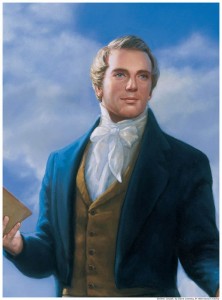
The following timeline puts some of Joseph Smith’s work, joys, and sorrows into their time and setting. Dates of events of particular interest are highlighted in the following colors:
Significant Personal Events
Significant Church History/Doctrinal Events
December 23: Born, Sharon Township, Windsor County, Vermont. (The Smith family lived in seven locations by the time Joseph turned 14: Sharon, Tunbridge, and South Royalton, Vermont; West Lebanon, New Hampshire; Norwich, Vermont; the village of Palmyra, and Palmyra Township, New York.)
Ca. 1813 Age 7
Exact Date Unknown West Lebanon, Grafton County, New Hampshire : The Smith children contract typhoid fever during an epidemic. Joseph’s leg becomes infected and he undergoes an operation to remove the infected bone rather than having an amputation. The miraculous surgery saves his life, though Joseph has to use crutches for many years.
1816 Age 11
Ontario County, New York: The Smith family moves to the village of Palmyra.
1820 Age 14

1823 Age 17
September 21–22 Joseph is instructed by the angel Moroni for the first time, who reveals to Joseph information about an ancient record that will need to be translated and the restoration of the gospel of Jesus Christ.
November 19 Palmyra Township : Joseph’s brother Alvin dies.
1824 Age 18
September 22 Joseph is instructed by the angel Moroni at the Hill Cumorah on this date until 1827.
1826 Age 20
March 20 South Bainbridge, Chenango County, New York : Joseph is tried and acquitted on the fanciful charge of being a “disorderly person.” Josiah Stowell, Joseph’s employer, testified on Joseph’s behalf.
1827 Age 21
January 18 South Bainbridge, New York : Joseph marries Emma Hale.
September 22 After years of instruction, Joseph obtains the brass plates from the angel Moroni at Hill Cumorah. Emma accompanies him on the trip.
December Because of persecution, Joseph and Emma decide to leave Manchester and move to Harmony, Pennsylvania to live with Emma’s parents.
1828 Age 22
February New York City : Martin Harris obtains certificate of authenticity from Professor Charles Anthon stating Joseph’s translation of a set of ancient characters is correct. Anthon asks where the characters were found. Upon hearing Joseph’s story, Anthon withdraws certification and offers to translate the gold plates himself. Learning that part of the plates are sealed, he says, in fulfillment of prophecy ( Isaiah 29:11 ), “I cannot read a sealed book.”
April 12 Harmony, Susquehanna County, Pennsylvania : Joseph Smith commences translation of the Book of Mormon with Martin Harris as scribe.
June 14 Palmyra Township: Martin Harris leaves Harmony with 116 translated pages of the Book of Mormon, against the Lord’s counsel, to show them to others and convince them of the truth of the translation. The pages are lost between June and July.
June 15 Harmony, Pennsylvania : Joseph and Emma’s first son, Alvin, is born. He dies within hours.
July Joseph’s first known recording of a revelation immediately after receiving it ( Doctrine and Covenants 3 ).
July The interpreters and plates are taken from the Prophet by the angel Moroni.
September 22 The interpreters and plates are returned to the Prophet by angel Moroni.
1829 Age 23
February Joseph Smith Sr. visits Joseph. Joseph Smith Jr. receives revelation about his father, now found in Doctrine and Covenants Section 4 .
April 5 Harmony, Pennsylvania : Oliver Cowdery arrives from New York and work on the translation recommences on Apr 7.
May 15 Harmony, Pennsylvania : Joseph and Oliver receive the Aaronic Priesthood from John the Baptist and are baptized.
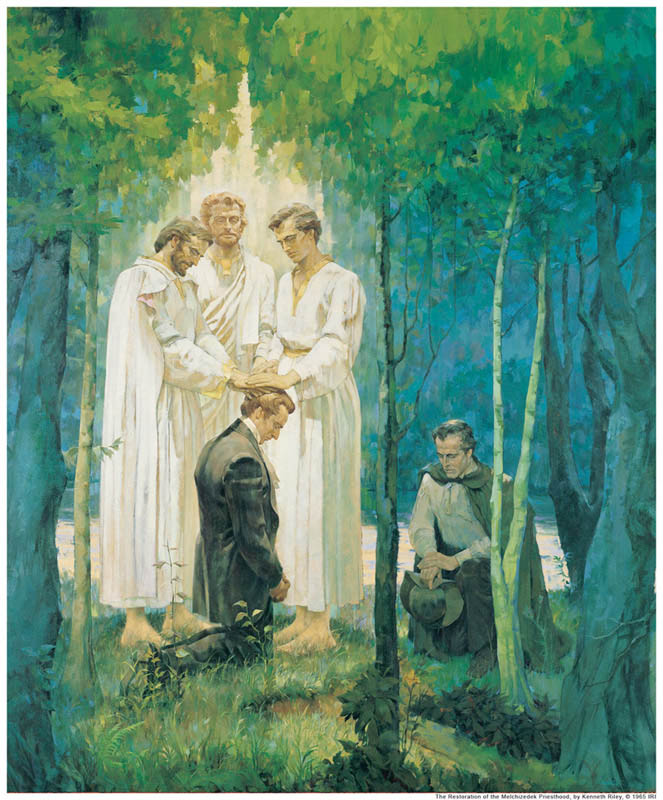
June 1 Fayette, New York : Joseph moves and stays with the Peter Whitmer family, continuing the translation of the Book of Mormon.
June Fayette, Seneca County, New York : Joseph finishes Book of Mormon translation; three witnesses view the plates, see angel Moroni, and hear the voice of God; Manchester Township eight witnesses see and handle the plates.
June–July Harmony : Joseph returns home with Emma.
1830 Age 24
March 26 Palmyra, New York : The Book of Mormon is made available to the public at E. B. Grandin’s Bookstore.
April 6 Fayette, New York : Joseph Smith officially organizes The Church of Jesus Christ of Latter-day Saints. The priesthood offices of deacon, teacher, priest, and elder are announced (See Doctrine and Covenants 20 .)
June 28 Joseph Smith is arrested on false charges of disorderly conduct and is acquitted.
June 30–March 1831 Joseph continues translating the writings of Moses (chapters 2–8).
Last week of August Harmony : Joseph and Emma move to Fayette.
September and October Under God’s direction, Joseph calls the first Mormon missionaries.
1831 Age 25
January 2 Joseph receives revelation detailing why the Church must move to Ohio ( Doctrine and Covenants 38 ); the Lord promises his law and an endowment.
On or about February 1 Kirtland, Geauga County, Ohio: Joseph arrives in Kirtland, which will be the seat of Church government for the next seven years.
February 4 Edward Partridge is called as the first bishop ( Doctrine and Covenants 41 ).
February 9 In fulfillment of Doctrine and Covenants 38 , the Prophet receives “the Law” ( Doctrine and Covenants 42 ).
April 30 Joseph and Emma’s twins, Louisa and Thaddeus, are born premature; they live only three hours.
Spring Joseph miraculously heals two women.
May 9 Joseph and Emma adopt newborn twins Joseph and Julia Murdock whose mother died in childbirth.
June 3 The office of high priest is announced at the fourth general conference of the Church.
June 19 Joseph starts for Missouri to designate the “land of Zion.”
July 20 Independence, Jackson County, Missouri : Jackson County is designated the center place for Zion and its temple ( Doctrine and Covenants 57 ).
August 3 Joseph dedicates the site for a temple in Missouri.
September 12 Ohio : Joseph moves to Hiram, Portage County.
November 1 Joseph compiles all of the revelations he has received so far and the members of the Church decide to print them under the name Book of Commandments . This book is now known as the Doctrine and Covenants.
December 3 Joseph receives a revelation calling him and Sidney Rigdon on missions. They leave Kirtland to start their mission in Southern Ohio.
1832 Age 26
January 10 Joseph and Sidney return to Kirtland.
January 25 Joseph is officially sustained as president and prophet of The Church of Jesus Christ of Latter-day Saints. He serves in this position until his death.
February 16 Joseph receives, with Sidney Rigdon, a vision of the three degrees of glory, which reveals doctrine about the life after death ( Doctrine and Covenants 76 ).
March 24 Hiram, Ohio : Joseph and Sidney Rigdon are taken by a mob in the middle of the night and tarred and feathered.
March 29 Joseph and Emma’s adopted son, Joseph Murdock, dies in consequence of exposure the night Joseph was tarred and feathered. Joseph had been caring for the sick infant when he was taken, and the baby was left alone with the door letting the cold in.
October–November Albany, New York and Boston, Massachusetts : Joseph serves a mission with Newel K. Whitney (see Doctrine and Covenants 84:114 ).
November 6 Kirtland : Joseph Smith III is born a few hours before Joseph’s return home from his mission to the East.
1833 Age 27
January 22–23 Kirtland : Joseph organizes the School of the Prophets (see Doctrine and Covenants 88:70–80, 117–141 ).
February 27 Joseph receives the revelation on the Word of Wisdom ( Doctrine and Covenants 89 ), the Mormon health code.
March 18 Kirtland : Joseph organizes the First Presidency of the Church from the presidency of the High Priesthood, with Joseph Smith as the President, and Sidney Rigdon and Frederick G. Williams as counselors.
June 1 Work begins on the temple in Kirtland.
July 23 Kirtland : The temple cornerstones are laid.
October 5–November 4 Joseph serves another mission to Pennsylvania, New York, and parts of Canada.
November 22 Joseph learns of the expulsion of the Saints from Zion (Jackson County, Missouri) and the tragic consequences of mob action in Missouri.
December 18 The priesthood office of evangelist, or patriarch, is announced. The first patriarchal blessings of this dispensation are given to Joseph’s parents, three brothers, and Oliver Cowdery.
1834 Age 28
February 17 Kirtland : The first stake of the Church is organized with Joseph as stake president.
February 26 In accordance with revelation, Joseph begins recruitment for Zion’s Camp, a group of men who travelled to help the Saints expelled from Jackson County in Missouri (see Doctrine and Covenants 101 , Doctrine and Covenants 103 ).
May 8 Joseph leaves for Missouri, heading one of two branches of Zion’s Camp.
June 22 The “Fishing River” revelation ( Doctrine and Covenants 105 ) disbands Zion’s Camp.
July Joseph returns to Kirtland after Zion’s Camp is disbanded.
September 1 Joseph personally works on the temple in Kirtland.
October Pontiac, Michigan : Joseph visits Saints.
1835 Age 29
February 14 Joseph organizes the Quorum of the Twelve Apostles.
February 28 Joseph organizes the Quorum of the Seventy.
March 28 Joseph receives revelation on priesthood ( Doctrine and Covenants 107 ), outlining the responsibilities of the offices of the priesthood.
July 9 Egyptian mummies and papyri are purchased from Michael Chandler with funds from some of the Saints donated for that purpose.
July 19 Joseph begins translating the papyri from Michael Chandler. The translation will be known as the Book of Abraham in the Pearl of Great Price.
September The first edition of the Doctrine and Covenants is completed.
1836 Age 30
January 21 Joseph receives a revelation about celestial glory and sees his deceased brother ( Doctrine and Covenants 137 ), Alvin, in heaven. He learns that God will save those who were righteous but did not have the gospel.

April 3 Joseph and Oliver Cowdery receive a series of visions in the Kirtland Temple. The Lord appears and accepts the temple; Moses restores the keys of the gathering of Israel; Elias restores the keys of the dispensation of the gospel of Abraham (the eternal family order); Elijah restores the keys of fullness of the priesthood sealing power ( Doctrine and Covenants 110 ).
June 20 Kirtland : Frederick Granger Williams Smith is born to Joseph and Emma.
July 25–September Salem, Massachusetts : Joseph serves a mission.
November 2 Joseph helps organize the Kirtland Safety Society Bank.
1837 Age 31
May Kirtland : A major internal Church dissension begins with the economic Panic of 1837, which causes many banks (including the Kirtland Safety Society) to fail. Many call Joseph a fallen prophet.
June Joseph sends the first missionaries to England; they arrive July 19.
1838 Age 32
January 12 Joseph leaves Kirtland to escape mob violence associated with apostasy of Saints there. He waits in Norton for his family to join him. He is followed for nearly two hundred miles by those who threatened him.
March 14 Joseph arrives with family in Far West, Caldwell County, Missouri.
June 2 Far West, Missouri :Alexander Hale Smith born to Joseph and Emma.
July 4 Far West : Cornerstones are laid for a temple.
July 8 Joseph receives a revelation concerning tithing and institutes it as a part of the Church.
August 6 Gallatin, Daviess County, Missouri : Some Latter-day Saints suffer in election-day violence when they go to vote because they are anti-slavery.
October 9 The Prophet records that in answer to Latter-day Saint pleas to government for protection from increasing mob violence, Missouri Governor Lilburn W. Boggs replied that “the quarrel was between the Mormons and the mob.”
October 25 The Battle of Crooked River results in the deaths of Elder David W. Patten of the Twelve and of a Missouri state militiaman.
October 27 Jefferson City, Missouri : Responding to false and inflammatory reports that the Saints are committing aggressive actions, Governor Boggs issues his “extermination order” allowing citizens to torment and drive out the Saints from Missouri under threat of death.
October 30 Daviess County, Missouri : Murderous attack on Latter-day Saints at Haun’s Mill.
October 31 The Prophet and other Church leaders are taken prisoners during what they were told would be a peace talk with leaders of the Missouri state militia besieging Far West.
November 1 Arbitrarily and without any foundation, the Prophet is sentenced to death “as a warning to the Mormons” after an irregular court martial; the Prophet’s life is spared through the courage of General Alexander W. Doniphan. Members of the state militia plunder Far West.
December 1 Clay County, Missouri : After an irregular court of inquiry in Richmond, the Prophet and several others are imprisoned in Liberty Jail, to await later trial on false charges of treason and murder. The charge of treason had to do with the Saints’ resisting the mob-militia, and the charge of murder was due to the death the militiaman at the Battle of Crooked River. Joseph Smith was accused of being an accessory though he was not present.
1839 Age 33
March 20–25 While a prisoner in Liberty Jail, Joseph receives Doctrine and Covenants 121 , 122 , and 123 .
April 16 Columbia, Boone County, Missouri : On the way to trial (after winning a change of venue), Joseph is allowed by his guards to escape.
April 22 Quincy, Adams County, Illinois : Joseph joins his family.
May 1 Commerce (later Nauvoo), Illinois : Joseph purchases land for the Saints to live on.
June 27–approx. August 8 Joseph teaches members of the Quorum of the Twelve Apostles before their second major mission to England.
July 21–22 Nauvoo, Illinois, and Montrose, Iowa : Great days of healing among the Saints stricken with malaria.
October 29, 1839 Washington, D.C. : Joseph travels to present to Congress the redress petitions for the grievances of the Missouri Saints. His visits with both President Martin Van Buren (November 29) and members of Congress prove fruitless.
1840 Age 34
June 13 Emma gives birth to Don Carlos Smith.
August 15 The first baptism for a deceased person is performed. Joseph pronounces that the ceremony is valid.
September 14 Nauvoo : Joseph Smith, Sr. passes away.
October 3–4 A conference is held. Joseph speaks on building a temple in Nauvoo, baptism for the dead, and the restoration of all ordinances.
1841 Age 35
January 19 Joseph receives instruction for the Saints to build the Nauvoo Temple and Nauvoo House; key priesthood officers are specified; the ordinance of baptism for dead is officially introduced ( Doctrine and Covenants 124 ).
February 1, 4 Joseph is elected to the Nauvoo City Council and as lieutenant general of the Nauvoo Legion (city militia).
Spring Joseph performs the first eternal marriage sealing with the keys restored by Elijah.
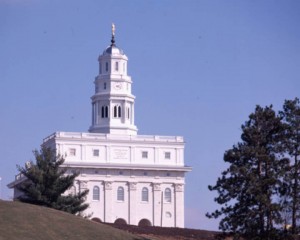
June 5 Joseph is again arrested on false charges of treason and murder dating from his arrest and imprisonment in Liberty Jail, the intent being to return him to Missouri for trial. The writ for arrest was dismissed on June 10, 1841. The Prophet said his defense relied in part on the fact “that the indictment, in Missouri, was obtained by fraud, bribery and duress, all of which I was prepared to prove.” Joseph was let go.
August 7 Nauvoo : Joseph’s brother Don Carlos dies.
August 15 Joseph’s son Don Carlos dies at fourteen months old.
November 8 Joseph dedicates the baptismal font in the basement of the Nauvoo Temple.
1842 Age 36
January 5 Joseph begins operating a general store in Nauvoo known as the Red Brick Store.
February 6 Joseph and Emma’s son dies at birth (no name given).
February 15 Joseph becomes the editor of the Nauvoo paper The Times and Seasons .
March 1 Joseph begins publishing the Book of Abraham; The Articles of Faith are printed in The Times and Seasons .

May 4 In an upper room of the Red Brick Store at Nauvoo, the Prophet administers the first extended endowment ordinances; nine men receive them, including Brigham Young, Heber C. Kimball, and Willard Richards.
May 19 Joseph is elected mayor of Nauvoo.
August 6 Joseph prophecies the Saints will continue to suffer persecution and will be driven to the Rocky Mountains, where they will become a mighty people.
August 8 Joseph goes into hiding after arrest warrants without any foundation are issued, falsely charging him with complicity in an attempt to assassinate Missouri Governor Lilburn W. Boggs; the charges signal that the Church’s Missouri enemies will go to any length to capture the Prophet.
September 1, 6 By letter, Joseph announces new guidelines for the administration of baptisms for the dead ( Doctrine and Covenants 127, 128 ).
December 21 Joseph goes on trial to determine if he can be legally required to return to Missouri to face false charges. It is found illegal to send Joseph to Missouri and Joseph is released.
December 26 Joseph voluntarily surrenders to arrest in Nauvoo on the far-fetched Missouri charge of attempted assassination of Lilburn W. Boggs.
1843 Age 37
January 5 Joseph is released by a federal judge in Springfield on a ruling that he is protected from arrest because of his Illinois citizenship.
May 28 Joseph is sealed to Emma Smith for time and eternity.
July 12 The revelation on celestial marriage is recorded ( Doctrine and Covenants 132 ).
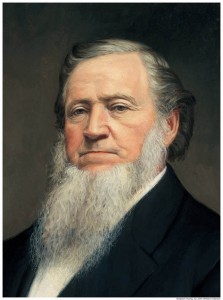
1844 Age 38
January 29 The Prophet announces his candidacy for President of the United States.
February 20 Joseph instructs the Twelve Apostles to oversee the organization and outfitting of exploring parties to search out a new location for the Saints in the West.
March The Prophet delivers his last charge to the Twelve Apostles, putting responsibility for the work of the kingdom on their shoulders.
April 7 Delivers what is now known as the King Follett Discourse (so named for King Follett, at whose funeral Joseph delivered the speech), a doctrinal landmark.
June 7 The Nauvoo Expositor is published, inciting anger and fear in Nauvoo: anger for its vilification of the Prophet and its accusations against other Church leaders; fear from its call for a repeal of the Nauvoo charter so that local government would be taken out of the hands of the Saints.
June 10 Concluding that they are operating within the prerogatives granted by the Nauvoo charter granted to the city by the state of Illinois, the Nauvoo city council passes an ordinance and directs the Prophet as mayor to “abate” the Nauvoo Expositor as a “nuisance”; the press is destroyed.

June 27 Joseph is martyred at Carthage Jail with his brother Hyrum in Hancock County, Illinois, killed by a mob who charged the jail.
June 28 The funeral of Joseph and Hyrum takes place.
June 29 Joseph and Hyrum are buried in Nauvoo.
November 17 David Hyrum Smith is born to Emma after Joseph’s death.
- Book of Mormon
- Book of Mormon Translations
- Current Church Leader Bios
- Early History
- European Saints
- General Conference
- Historical Landmarks
- Historical Stories
- Inspiring Stories from Latter-day Saints
- Interesting Church Members
- Joseph and Emma Smith Descendants
- Joseph Smith
- Joseph Smith's Family
- LDS Views on War
- Modern History
- Mormon Beliefs
- Mormon Historical Sites
- Mormon Missionary
- Mormon Temples
- Mormon Women Leaders
- Past Leader Bios
- Uncategorized
- Voice of Christ
- Who's Who in Mormon History
Free Scriptures
The Mormon Church distributes free copies of the King James Version of the Bible and the Book of Mormon . For your free copy of the Bible, go to Free Holy Bible and for a free Book of Mormon, go to Free Book of Mormon
Joseph Smith's First Vision

Pin It on Pinterest
The Life of Joseph Smith: The First Vision
How the First Vision Changed the World

Who was Joseph Smith?
If you’ve heard about The Church of Jesus Christ of Latter-day Saints, you may wonder who started this church. Joseph Smith Jr. is perhaps best known as the man, through whom God restored His true church, The Church of Jesus Christ of Latter-day Saints. But long before he was known as the founder of a worldwide religious movement, Joseph Smith was a humble boy who simply desired to know which church he should join.
How did Joseph Smith become interested in religion?
As an adult, Joseph recollected that “at about the age of twelve years my mind became seriously impressed with regard to the all-important concerns for the welfare of my immortal soul” (“ History, circa Summer 1832, ” 1–2, josephsmithpapers.org , spelling, punctuation, capitalization, and grammar standardized). During Joseph’s early teens, he and his family lived in a part of rural New York state that became known for its religious enthusiasm. Palmyra, the town where Joseph and his family lived, and the surrounding area were known as the “burned-over district” because of the religious revivals that repeatedly swept the region (see “ First Vision Accounts ,” Gospel Topics, churchofjesuschrist.org/study/manual/gospel-topics-essays?lang=eng ).
Joseph was both moved and confused by this religious excitement and earnestly desired to know which of the many sects laboring for converts was God’s true Church (see Steven C. Harper, “The First Vision: A Narrative from Joseph Smith’s Accounts,” history.churchofjesuschrist.org ; see also Joseph Smith—History 1:9–10 ). Joseph, who was fourteen years old at the time, turned to the Bible for help. Inspired by James 1:5, which reads “if any of you lack wisdom, let him ask of God,” Joseph went to the woods near his home to seek answers in prayer (see Joseph Smith—History 1:11-15 ).
What is the First Vision?
After Joseph entered the woods, he knelt in a secluded grove of trees and began praying aloud for the first time in his life (see Joseph Smith—History 1:14 ). But almost as soon as young Joseph began praying, he was left unable to speak. Joseph explained, “I had scarcely [started praying], when immediately I was seized upon by some power which entirely overcame me, and had such an astonishing influence as to bind my tongue so I could not speak” ( Joseph Smith—History 1:15 ). Joseph also related that “thick darkness gathered around [him],” and he feared that he would be destroyed ( Joseph Smith—History 1:15 ).
In response to this overwhelming opposition and darkness, Joseph increased his efforts to pray. He then experienced one of the greatest miracles of modern times, what Latter-day Saints call the First Vision. Joseph recalled of this experience, “Exerting all my powers to call upon God to deliver me out of the power of this enemy which had seized upon me, and at the very moment when I was ready to sink into despair and abandon myself to destruction . . . , I saw a pillar of light exactly over my head, above the brightness of the sun, which descended gradually until it fell upon me. It no sooner appeared than I found myself delivered from the enemy which held me bound. When the light rested upon me I saw two Personages, whose brightness and glory defy all description, standing above me in the air. One of them spake unto me, calling me by name and said, pointing to the other— This is My Beloved Son. Hear Him! ” ( Joseph Smith—History 1:16–17 ).
Latter-day Saints believe that in this, Joseph Smith’s First Vision, both God the Father and Jesus Christ spoke. They instructed Joseph not to join any of the churches then on the earth, as “none of them was acknowledged of God as his church and kingdom,” and promised Joseph that “the fulness of the gospel should at some future time be made known unto [him]” (Joseph Smith, “Church History,” Times and Seasons, Mar. 1, 1842, 707, josephsmithpapers.org ). Latter-day Saints believe that the fulness of the gospel was restored through Joseph Smith when the Lord established The Church of Jesus Christ of Latter-day Saints through him ten years later.

Why is the First Vision important to The Church of Jesus Christ of Latter-day Saints?
Latter-day Saints view Joseph Smith’s First Vision as the essential first step in the establishment of The Church of Jesus Christ of Latter-day Saints. Through the First Vision, we learn two truths that are central to Latter-day Saint doctrine. First, that God and Jesus Christ are two separate beings, each with a perfect, glorified body. Second, that God continues to reveal His will to humankind today.
After the First Vision, Joseph Smith translated the Book of Mormon, a volume of ancient scripture that teaches of Jesus Christ; restored the true priesthood and the sealing power that allows families to be together after this life; and received many more revelations from God. Latter-day Saints today believe that Joseph Smith was truly God’s prophet.
How Can I Learn More?
To learn more about Joseph Smith’s remarkable life and mission, visit comeuntochrist.org .
- Gospel Topics

In the spring of 1820, God the Father and Jesus Christ appeared to Joseph Smith as he prayed in a grove of trees near his home in western New York. This event is known as the First Vision.

Short film produced for the Church History Museum depicting Joseph Smith's First Vision, including details drawn from each of Joseph Smith's accounts.

Three hundred miles from New York City, there’s a ten-acre patch of forest that more than 100,000 people visit every year.
Why do they choose to come here?
- Navigate to any page of this site.
- In the menu, scroll to Add to Home Screen and tap it.
- In the menu, scroll past any icons and tap Add to Home Screen .
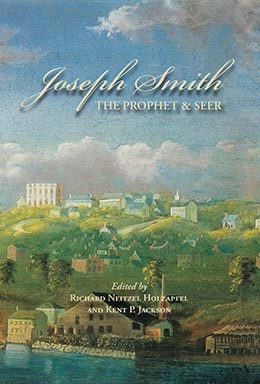
Joseph Smith, the Prophet and Seer
Richard neitzel holzapfel and kent p. jackson , editors, joseph smith and the redemption of zion, 1834, alexander l. baugh.
Alexander L. Baugh, “Joseph Smith and the Redemption of Zion,” in Joseph Smith, the Prophet and Seer , ed. Richard Neitzel Holzapfel and Kent P. Jackson (Provo, UT: Religious Studies Center, Brigham Young University; Salt Lake City: Deseret Book, 2010), 151–94.
Alexander L. Baugh is an associate professor of Church history and doctrine at Brigham Young University and an editor of The Joseph Smith Papers when this was published.
In 1834, the Church was still young—less than four years old. Membership was probably between 2,000 and 2,500, with approximately 1,200 Saints living in Missouri and another six to eight hundred living in Kirtland and northeastern Ohio. The remaining three to four hundred resided in scattered branches primarily in Pennsylvania, New York, Michigan, and Ontario, Canada.
Joseph Smith himself was young—a youthful twenty-eight; his wife Emma, twenty-nine. Their children were young. Julia Murdock Smith, their adopted daughter, was almost three. Joseph III, his namesake, was just over a year.
When I began to write this sketch of Joseph Smith’s life in 1834, I tried to put myself in the place of Joseph Smith. What would he think were the highlights or major events of his life during that year? Based on the available historical records, I have sincerely tried to piece together a one-year narrative of his life that would be representative of the Prophet of the Restoration. I did the best I could. I hope Joseph would approve.
Kirtland Stake High Council Organized
With the growth of the Church and other advances came the need to expand Church organization and widen its leadership. During the first three years of the Church (1830–33), Church councils composed of elders, bishops, and high priests had been attending to problems in the Church. But a higher governing body was needed to resolve “important difficulties . . . which could not be settled by the church or the bishop’s council” (Doctrine and Covenants 102:2). Such responsibilities included the formulation of rules and policies and the disciplining of errant members.
On February 17, 1834, Joseph Smith told a body of priesthood brethren and others who were assembled that he “would show the order of councils in ancient days as shown to him by vision.” [1] He then proceeded to organize a new council, known as the stake high council, or in more familiar terms, the Kirtland Stake. The creation of the Kirtland Stake marked the first time a formal ecclesiastical subunit of the Church was established. The council was to comprise a presidency of three high priests with twelve additional high priests selected as councilors with responsibilities to govern in local administrative and judicial matters. Significantly, Joseph Smith, Sidney Rigdon, and Frederick G. Williams, who were serving at the time as the Church’s First Presidency, were also chosen to serve as the presidency of Kirtland Stake. [2] The minutes of the first meeting of the Kirtland stake presidency and high council were recorded in the Kirtland Council Minute Book and later canonized as section 5 in the 1835 edition of the Doctrine and Covenants. Today, the minutes make up Doctrine and Covenants section 102.
The Zion’s Camp Revelation, Recruitment, and Preparation
With a governing body in place in Kirtland, Joseph turned his attention to a far weightier matter. On November 25, 1833, Orson Hyde and John Gould arrived in Kirtland, Ohio, after having traveled from Missouri, bringing word of the forced removal of some 1,200 Latter-day Saints from Jackson County during the first week of November. [3] Meanwhile, Missouri Church leaders informed state officials of the events surrounding their expulsion and requested assistance. R. W. Wells, Missouri’s attorney general, was the first to respond and was sympathetic. Two weeks after the expulsion, he wrote to David Rice Atchison and Alexander W. Doniphan, two Liberty lawyers who had been secured as legal counsel by the Church, informing them that if the Mormons “desire to be replaced in possession of their property . . . an adequate force will be sent forthwith to effect that object.” Furthermore, he believed the Mormons had the legal right to “organize themselves into regular companies, or a regular company of militia, either volunteers or otherwise.” [4] Based upon Wells’s conjecture, on December 6, the leading Missouri elders petitioned Missouri governor Daniel Dunklin directly, requesting they be restored to their “lands, houses, and property, and protected in them by the militia of the state, if legal, or by a detachment of the United States Rangers.” [5] Writing to Oliver Cowdery in December 1833, John Corrill expressed hope that the governor would take action in their behalf. “The Governor had manifested a willingness to restore us back, and will if we request it,” he wrote, “but this will be of but little use unless he could leave a force there to help protect us.” [6] Later, Dunklin reiterated this position in a formal reply. He fully acknowledged the Mormons had a right to organize a military body; “indeed it is [your] duty to do so,” he wrote. However, “as to the request for keeping up a military force to protect your people, and prevent the commission of crimes and injuries,” he believed such a request did not warrant the use of state troops since in his opinion it was not, under militia law, an “emergency.” [7] Based upon what they were told by Missouri officials, Mormon leaders in Missouri believed the following would transpire. First, the state would render assistance by mustering a militia force which would help reinstate the displaced Saints back in Jackson County. Second, the Latter-day Saints were authorized to organize their own independent military unit, which body would join forces with the state militia in helping restore the Saints to their lands. And third, after the Jackson Saints were reinstated, the Mormon contingent would remain for a time to provide protection and maintain order until peace was restored.
A revelation given to the Prophet Joseph Smith the previous December (1833) intimated the Church would respond to the Missouri difficulties with an organized military body. The revelation summoned “all the strength of mine house, which are my warriors, my young men, and they that are of middle age also among all my servants, who are the strength of mine house . . . [to go] straightway unto the land of my vineyard, and redeem my vineyard; for it is mine” (Doctrine and Covenants 101:55–56). When Elders Parley P. Pratt and Lyman Wight arrived in Kirtland on February 22, 1834, following a lengthy midwinter journey from Missouri, the two men informed Joseph Smith of the latest developments in connection with the exiled members. The two men delivered a letter written by William W. Phelps informing the Prophet that “the Governor is willing to restore us, but . . . the constitution gives him no power to guard us when back.” [8] Clearly the Missouri Saints were asking for the Kirtland members to come to their assistance. On February 24, two days after the arrival of Pratt and Wight, Joseph Smith received a revelation reiterating the previous one (see Doctrine and Covenants 101), calling for five hundred men but settling with no less than one hundred recruits to make up the company (see Doctrine and Covenants 103:32–34). The revelation instructed the Saints to organize companies of tens, twenties, fifties, and hundreds (see Doctrine and Covenants 103:30) and called for Joseph Smith to take command of the entire operation (see Doctrine and Covenants 103:21–22, 35). Seven additional men—Parley P. Pratt, Lyman Wight, Sidney Rigdon, Hyrum Smith, Frederick G. Williams, Orson Hyde, and Orson Pratt—were instructed to obtain supplies and money, recruit volunteers, and organize the companies (see Doctrine and Covenants 103:29–34, 37–40). Later that same day the Prophet met with the Kirtland high council and told them he was going to Missouri and asked for volunteers to head up the expedition later known as Zion’s Camp. [9] May 1, 1834, was set as the departure date for the company. [10] For eight months Zion’s Camp occupied the Prophet’s attention, and it was the primary focus of his activity during the months preceding the journey (January–April), during the expedition (May–July), and ending with his return to Kirtland (August).
One can only imagine the weight of responsibility Joseph Smith felt. The task must have been formidable and daunting. He was young, only twenty-eight years old, and inexperienced in military activities and affairs. Furthermore, the expedition would entail traveling over nine hundred miles (one way) through four states over rough roads and sometimes uncharted terrain. In addition, two months of food, provisions, and supplies would be needed for more than two hundred individuals. Perhaps most significant, however, was the fact that he would ultimately be responsible for the overall day-to-day operations and activities and the physical safety and well-being of the participants. For Joseph Smith, Zion’s Camp tested his leadership skills at an early stage in his prophetic ministry.
Joseph Smith wasted no time in moving forward with his plans to organize Zion’s Camp. On February 26, only two days after the receipt of Doctrine and Covenants section 103, he left Kirtland in company with Parley P. Pratt to recruit volunteers. The two leaders traveled east, visiting Church branches and recruiting men and means primarily in northeastern Ohio and western New York. The Prophet was absent from Kirtland for over a month, returning on March 28. [11] On that date, his journal includes the following entry written in his own hand: “Came home found my Family all well and the Lord be praised for this blessing.” [12] Orson Hyde and Orson Pratt made rounds in Pennsylvania; Lyman Wight and Sidney Rigdon visited congregations in Ohio, Pennsylvania, and New York; Frederick G. Williams and Hyrum Smith labored in the East for a period of time. In late April, Hyrum Smith and Lyman Wight went to Michigan to recruit volunteers.
Recruiting men for Zion’s Camp proved to be difficult. Many expected there would be armed conflict and that their safety could be in jeopardy. To Brigham Young and his older brother Joseph, the Prophet promised: “If you will go with me in the camp to Missouri and keep my counsel, I promise you, in the name of the Almighty, that I will lead you there and back again, and not a hair of your heads shall be harmed.” [13] Family and work responsibilities caused others to be reluctant or not to heed the call altogether. On the other hand, the prospects of participating in an extended overland adventure to western Missouri proved exciting for the more adventuresome type, such as sixteen-year-old George A. Smith, younger cousin of the Prophet. Although underage, he was permitted to go and placed under the care and keeping of the Prophet. His responsibilities included taking care of Joseph’s arms and assisting Zebedee Coltrin, one of the camp’s cooks. [14] Other Smith family members also enlisted, including Joseph’s younger brother William Smith (age twenty-three); Wilkins Jenkins Salisbury (age twenty-three), the Prophet’s brother-in-law; and Jesse J. Smith (age twenty-five), another younger cousin.
Joseph Smith v. Philastus Hurlbut Court Hearing in Chardon
April 1834 was an extremely busy time for Joseph Smith as he was putting final plans in place for the departure of Zion’s Camp. However, during the first week of April the Mormon leader was also involved in a highly publicized court hearing involving Philastus Hurlbut (his first given name was actually “Doctor”), a disgruntled ex-Mormon. Hurlbut had joined the Church in Kirtland in March 1833, but his membership in the Church was short lived when he was excommunicated the following June on the charge of adultery. Following his dismissal, Hurlbut traveled to Palmyra, New York, where he collected sixteen affidavits from individuals in the community who claimed to have associated with the Smith family. The subjectively gathered affidavits contained negative and derogatory reports about Joseph Smith and the entire Smith family. Hurlbut’s affidavits and a series of nine letters written by Ezra Booth, also an ex-Mormon, were used as the basis for the first anti-Mormon book, Mormonism Unvailed , published later in 1834 in Painesville, Ohio, by Eber D. Howe, editor of the Painesville Telegraph . [15] But Hurlbut had also personally threatened Joseph Smith’s life, resulting in the charges that culminated in a court hearing. The hearing convened in Geauga County, Court of Common Pleas in Chardon, Ohio, on April 2 and concluded on April 7. At the conclusion of the hearing, Hurlbut was found guilty and ordered to pay a two-hundred-dollar bond to keep the peace for six months. He was also ordered to pay the court cost, which amounted to $112.59. In his journal dated April 7, Joseph notes that Hurlbut’s conviction “was in answer to our prayer for which I thank my heavenly father.” [16]
Medina Conference—Vision of Adam and Eve
On April 18 the Prophet, accompanied by Sidney Rigdon, Oliver Cowdery, and Zebedee Coltrin, left Kirtland to attend a conference in Medina County, situated fifty miles south of Kirtland, near present-day Akron, Ohio. The Kirtland Council Minute Book contains a summary of the Prophet’s remarks on the occasion of the first day of the conference, April 21. Among other subjects, he recounted how he obtained and translated the Book of Mormon, the occasion when he and Oliver Cowdery received the Aaronic and Melchizedek Priesthoods, and the events associated with the organization of the Church. Returning to the significance of the Book of Mormon and modern revelation, he told his hearers, “Take away the book of Mormon, and the revelations, and where is our religion? We have none.” [17]
During the course of the two-day conference, Joseph, Oliver, and Zebedee experienced a most unusual vision. The Prophet asked Oliver and Zebedee to walk with him “to a place where there was some beautiful grass, and grapevines,” Coltrin later recounted. The Prophet then requested they each pray in turn. After praying, Joseph said, “‘Now breth[r]en . . . we will see some visions.’” Joseph laid on the ground, and Oliver and Zebedee rested their heads on his outstretched arms. “The heavens gradually opened,” Coltrin recalled, and the brethren “saw a golden throne, on a circular foundation, something like a light house, and on the throne were two aged personages, having white hair, and clothed in white garments.” These personages were “the two most beautiful and perfect specimens of mankind” Coltrin had ever seen. Joseph called them “our first parents, Adam and Eve.” Coltrin remembered Adam as a “large broadshouldered man, and Eve as a woman . . . large in proportion.” [18]
Dissolution of the United Firm—Doctrine and Covenants 104
On April 23, 1834, two days after returning from Medina County, Joseph was directed by revelation to dissolve the Church’s business-holding company called the United Firm and to distribute its assets to the directors of the firm. The United Firm had been established in 1832 to assist the poor in the Church (see Doctrine and Covenants 78), but because of the firm’s heavy debt, its dissolution was advisable. The revelation, which makes up what is today Doctrine and Covenants 104, is often ignored simply because its detailed directives primarily discuss the distribution of the assets of the firm. [19] Interestingly, on April 28, 1834, five days after the receipt of Doctrine and Covenants 104, the Prophet received another revelation concerning the United Firm. It is not well known, primarily because it was never canonized. It comprises only three sentences, consisting of a total of eighty-eight words. [20]
Prophecy regarding the Future Size of the Church
One of those who responded to the call-up of Zion’s Camp was none other than twenty-seven-year-old Wilford Woodruff. On December 29, 1833, while living at Richland, Onondaga County, New York, Wilford and his older brother Azmon first heard the restored gospel preached by Zera Pulsipher and Elijah Cheney. Two days after being introduced to Mormonism (December 31), the two brothers were baptized and became part of the newly formed Richland Branch. In early April 1834, Parley P. Pratt visited Richland recruiting volunteers for Zion’s Camp. Azmon, who was married, declined the invitation, but Wilford, who was single, signed on, and on April 11, he left Richland to journey to Kirtland, where he arrived two weeks later on April 25. [21] Shortly after his arrival, he met Joseph Smith for the first time. Wilford’s recollections of that meeting were as follows:
I first met Joseph Smith in the streets of Kirtland. He had on an old hat, and a pistol in his hand. Said he, “Brother Woodruff, I’ve been shooting at a mark, and I wanted to see if I could hit anything.” And, said he, “Have you any objection to it?” “Not at all,” said I. “There is no law against a man shooting at a mark, that I know of.” He invited me to his house. He had a wolf skin, which he wanted me to help to tan; he wanted it to sit on while driving his wagon team. Now, many might have said. “You are a pretty [interesting] prophet; shooting a pistol and tanning a wolf skin.” Well, we tanned it, and used it while making a journey of a thousand miles. This was my first acquaintance with the Prophet Joseph. [22]
On April 27, three days before the scheduled departure of Zion’s Camp, Wilford heard Joseph Smith preach for the first time. The meeting took place in a small log schoolhouse in Kirtland. The Prophet’s remarks left a profound impression on Wilford, especially a prophecy made by the Mormon leader at the close of the meeting about the future size of the Church. Wilford wrote:
On Sunday the 27 of April the saints met togather and held a testamony meeting, and many of the elders spoke and bore their testamony; among the number was . . . Joseph Smith the Prophet who closed by saying “Brothering [brethren] we are laying the foundation of a great work and you know it not, you comprehend it not. The work we are engaged in will grow, spread, and increas[e] untill it will fill the land: it will go from sea to sea it will fill the Rocky Mountains: all nations will hear it: it will fill its destiny; It is the work of Almighty God, and he will maintain and defend it.” [23]
Speaking in general conference in April 1898, Woodruff reflected upon the April 1834 meeting and remarked:
On Sunday night the Prophet called on all who held the Priesthood to gather into the little log school house they had there. It was a small house, perhaps 14 feet square. But it held the whole of the Priesthood of The Church of Jesus Christ of Latter-day Saints who were then in the town of Kirtland, and who had gathered together to go off in Zion’s camp . . . . When we got together the Prophet called upon the Elders of Israel with him to bear testimony of this work. When they got through the Prophet said, “Brethren, I have been very much edified and instructed in your testimonies here tonight, but I want to say to you before the Lord, that you know no more concerning the destinies of this Church and kingdom than a babe upon its mother’s lap. You don’t comprehend it.” I was rather surprised. He said, “It is only a little handful of Priesthood you see here tonight, but this Church will fill North and South America—it will fill the world.” Among other things he said, “It will fill the Rocky Mountains. There will be tens of thousands of Latter-day Saints who will be gathered in the Rocky Mountains, and there they will open the door for the establishing of the Gospel among the Lamanites, who will receive the Gospel and their endowments and the blessings of God. This people will go into the Rocky Mountains; they will there build temples to the Most High. They will raise up a posterity there, and the Latter-day Saints who dwell in these mountains will stand in the flesh until the coming of the Son of Man. The Son of Man will come to them while in the Rocky Mountains.” [24]
New Name for the Church
On May 1, the scheduled date of departure of Zion’s Camp, the first group consisting of twenty men left Kirtland. [25] Joseph Smith may have purposely delayed his departure to preside at a conference scheduled for May 3. It appears that the main purpose for this conference was to discuss and adopt a new name for the Church. The conference minutes read:
MINUTES of a Conference of the Elders of the church of Christ, which church was organized in the township of Fayette, Seneca county, New-York, on the 6th of April, A.D. 1830. The Conference came to order, and Joseph Smith Jr. was chosen Moderator, and Frederick G. Williams and Oliver Cowdery, were appointed clerks. After prayer the Conference proceeded to discuss the subject of names and appelations, when a motion was made by Sidney Rigdon, and seconded by Newel K. Whitney, that this church be known hereafter by the name of THE CHURCH OF THE LATTER DAY SAINTS. Appropriate remarks were delivered by some of the members, after which the motion was put by the Moderator, and passed by unanimous voice. [26]
At the time of the organizational meeting in April 1830 the Church was simply called the Church of Christ (see Doctrine and Covenants 20:1). However, to distinguish themselves from other Christian denominations having similar titles, particularly Alexander Campbell’s Disciples of Christ, and because members believed the establishment of the Church was a restoration of the ancient order of the New Testament Christian Church under the leadership of Jesus Christ and his Apostles, members began identifying themselves as “Saints” living in the days preceding the second coming, or the Saints in the latter days. The adoption of the name The Church of the Latter Day Saints therefore marks the second of three names by which the Church has officially been known. The name remained in place for nearly four years (May 1834–July 1838). By revelation (see Doctrine and Covenants 115:4), on April 26, 1838, the former and latter names of the Church were essentially merged into one to form the current name of the Church—The Church of Jesus Christ of Latter-day Saints (albeit a hyphen has been added between “Latter” and “Day,” and “Day” is no longer capitalized).
Joseph Marches at the Head of Zion’s Camp
On Sunday, May 4, the day previous to the departure of Joseph Smith and the main company of Zion’s Camp from Kirtland, the Prophet gave some remarks and counsel. George A. Smith reported Joseph Smith’s words on the occasion:
He impressed upon them the necessity of being humble, exercising faith and patience and living in obedience to the commands of the Almighty, and not murmur at the dispensations of Providence. He bore testimony of the truth of the work which God had revealed through him, and promised the brethren that if they all would live as they should before the Lord, keeping his commandments, and not like the children of Israel murmur against the Lord and his servants, they should all safely return, and not one of them should fall upon the mission they were about to undertake; for if they were united and exercised faith, God would deliver them out of the hands of their enemies; but should they, like the children of Israel, forget God and his promises, and treat lightly his commandments, He would visit them in his wrath, and vex them in his sore displeasure. [27]
On Monday, May 5, the main company of Zion’s Camp, consisting of eighty-five men under the leadership of the Prophet, pulled out of Kirtland. Wagons were loaded with supplies, provisions, armaments, munitions, and “clothing and other necessaries to carry to [those] who had been robbed and plundered of nearly all their effects.” [28] Coincidentally, the same day the Prophet’s company left Kirtland, a smaller group consisting of seventeen persons left Pontiac, Michigan, under the direction of Hyrum Smith and Lyman Wight, with intentions of joining with the main body en route. [29] Significantly, at least twelve women and nine children are known to have traveled with the two divisions. [30]
For over a month, additional men and volunteers fell in with the company, increasing their ranks and numbers. Parley P. Pratt was the main recruiter. “I was chiefly engaged as a recruiting officer,” he wrote, “and, not being much with the camp, can give but little of its history. I visited branches of the Church in Ohio, Indiana, Illinois and Missouri, and obtaining what men and means I could, fell in with the camp from time to time with additional men, arms, stores, and money.” [31]
On Sunday, May 18, less than two weeks into the journey, near Richmond, Indiana, Joseph Smith wrote a heartfelt letter to his wife, Emma. The letter, written by his own hand, reflects his love of family, his concern for others, and his optimism:
My Dear Wife meeting being over I sit down in my tent to write a few lines to you to let you know that you are on my mind and that I am sensible of the dut[i]es of a Husband and Father and that I am well and I pray God to let his blessings to rest upon you and the children and all that are a round you untill I return to your society the few lines you roa wrote and sent by the ha[n]d of Brother Lyman [E. Johnson] gave me satisfaction and comfort and I hope you will continue to communicate to me by your own hand for this is a consolation to me that to convirse <with> you in this way in my lonely moments which is not easily discribed I will indeavour to write every Su[n]day if I can and let you know how I am <and> Brother Fredrick [G. Williams] will write to Oliver [Cowdery] and give him the names of the places we pass through and a history of our jou[rn]ey from time to time so that it <will> not be nessary for me to endevou[r] to write it but feel a satisfaction to write a few lines with my own hand in this way I can have the privelege to communicate some of my feelings that I should not dare to reveal as you know that <my> situation is a very critacal one Brother Jinkins [Salisbury] and William [Smith] Jese [J. Smith] and Jeorge [A. Smith] are all well and are humble are detirmined to be faithful and finally all the Kirtland Broth[r]en are well and cannot fail I must close for I cannot write on my knees sitting on the ground to edification O may the blessings of God rest upon you is the prayre of your Husband until death [Joseph Smith, Jr.] [32]
Zion’s Camp was a long-distance march, and most company members walked the entire distance from Ohio to Missouri and back. Most days the expedition covered between twenty and thirty miles; however, on occasion they traveled as many as forty. Hot, humid days, torrential rains, mud, uncomfortable sleeping conditions, broken equipment, and food shortages, in addition to unhealthy food, added to their suffering. Surviving records clearly reveal that physical fatigue, discomfort, sickness, hunger, and thirst proved to be the most trying of their ordeals.
One might expect that Joseph Smith, being the officer in charge, would have fared better than the others. However, he took few, if any, privileges. “The Prophet Joseph took a full share of the fatigues of the entire journey,” George A. Smith reported. “In addition to the care of providing for the Camp and presiding over it, he walked most of the time and had a full proportion of blistered, bloody, and sore feet.” [33] Heber C. Kimball wrote, “I frequently invited the Prophet to ride, seeing him lame and footsore. On such occasions he would bless me and my team with a hearty good will.” [34] George A. further recalled that the Prophet maintained a constant sense of optimism, never expressing the slightest dissatisfaction. “During the entire trip he never uttered a murmur or complaint, while most of the men in the Camp complained to him of sore toes, blistered feet, long drives, scanty supply of provisions, poor quality of bread, bad corn dodger, frouzy butter, strong honey, maggoty bacon and cheese, . . . even a dog could not bark at some men without their murmuring at Joseph.” [35]
Sadly, the hardships generated hard feelings, quarrels, and frequent contention among the company. Sylvester Smith was particularly outspoken and contentious, and his influence spread to other camp members. On Tuesday, June 3, after nearly a month’s travel, during their noon halt, Joseph stood on the back of a wagon and issued a condemnation and warning. George A. Smith reported him as having said, “The Lord was displeased with us; that our murmuring and fault-finding and want of humility had kindled the anger of the Lord against us; and that a severe scourge would come upon the Camp and many would die like sheep with the rot. He said, ‘I cannot stop it; it must come; but by repentance and humility and the prayer of faith, the chastisement may be alleviated but cannot be entirely turned away, for as the Lord lives this Camp must suffer a severe scourge for their wickedness and rebellion. I say it in the name of the Lord.’” [36] In spite of the pronouncement, some continued to display a contentious spirit.
On June 4, following nearly a month’s journey, Joseph dictated a letter to Emma wherein he notes some of his own ailments yet voices no disparagement:
My Dear Companion, I now embrace a few moments to dictate a few words that you may know how it is with us up to this date. We arrived this morning on the banks of the Mississippi, and were detained from crossing the river, as there was no boat that we could cross in, but expect a new one to be put into the river this evening, so that we are in hopes, to be able to cross to morrow, and proceed on our journey. A tolerable degree of union has prevailed among the brethren or camp up to the present moment, and we are all in better circumstances of health apparently than when we started from Kirtland . . . . I have been able to endur[e] the fatigue of the journey far beyond my most sanguine expectations, except have been troubled some with lameness, have had my feet blistered, but are now well, and have also had a little touch of my side complaint . . . . The whole of our journey, in the midst of so large a company of social honest and sincere men, wandering over the plains of the Nephites, recounting occasionaly the history of the Book of Mormon, roving over the mounds of that once beloved people of the Lord, picking up their skulls & their bones, as a proof of its divine authenticity, and gazing upon a country the fertility, the splendour and the goodness so indescribable, all serves to pass away time unnoticed, and in short were it not at every now and then our thoughts linger with inexpressible anxiety for our wives and our children our kindred according to the flesh who are entwined around our hearts; And also our brethren and friends; our whole journey would be as a dream, and this would be the happiest period of all our lives. We learn this journey how to travel, and we look with pleasing anticipation for the time to come, when we shall retrace our steps, and take this journey again in the enjoyment and embrace of that society we so much love . . . . Tell Father Smith [Joseph Smith Sr.] and all the family, and brother Oliver [Cowdery] to be comforted and look forward to the day when the trials and tribulations of this life will be at an end, and we all enjoy the fruits of our labour if we hold out faithful to the end which I pray may be the happy lot of us all. From your’s in the bonds of affliction. Joseph Smith Jr. [37]
In spite of their physical hardships, Zion’s Camp was also a spiritual time. Group prayers were conducted morning and evening. Sundays were usually reserved for rest for sabbath worship, including partaking of the sacrament, singing, preaching, and bearing testimony. The company experienced several miraculous healings, divine intervention, and at times demonstrated powerful expressions of faith. Experiences and encounters along the way provided the Prophet with opportunities to teach gospel principles and practical lessons about living a more Christlike life. The camp was also the object of his stern reproofs when he observed sin and error. He was known to have prophesied from time to time, and on at least two occasions he related visionary experiences he received while with the company. [38]
On June 5–6, following a month of travel through Ohio, Indiana, and Illinois, picking up recruits along the way, the Mormon army crossed the Mississippi near Louisiana, Missouri. On June 7 the troops arrived at a small branch of the Church known as the Salt River or Allred Settlement (named after James Allred, an early convert), situated in present-day Monroe County, where they waited for Lyman Wight and Hyrum Smith’s small company from Michigan. With the arrival of this last contingent on June 8, Zion’s Camp consisted of a force of just over two hundred men. Here, final preparations were made for the push to western Missouri. On June 12 the army of Israel broke camp and commenced the trek across northern Missouri. [39]
While camped on the Salt River, the Prophet sent Parley P. Pratt and Orson Hyde to Jefferson City, the state capital, to meet with Governor Dunklin, expecting to receive orders concerning the role Zion’s Camp would play in conjunction with the troops called out by the state. According to Elder Pratt, the governor backed down, refusing to intervene militarily, stating “he dare not attempt the execution of the laws in that respect, for fear of deluging the whole country in civil war and bloodshed,” but he believed the Saints should continue their efforts through the courts. [40] Dunkin’s position was devastating news because without the immediate support of state troops, the reinstatement of the displaced Missouri Saints in Jackson County—the primary object of Zion’s Camp—could not take place.
Immediately following their meeting with the governor, Elders Pratt and Hyde hurried to catch up with the company and to report Dunklin’s position to Joseph Smith. On June 15 the two men arrived in camp. Upon learning of the governor’s decision not to intervene, Joseph was extremely disappointed. What could they do now? How were they to proceed? In spite of the news, the decision was made to move on to at least meet and confer with the Church leaders and members living in Clay County and hope that a revelation would be received giving some direction.
Meanwhile, their movements had not gone unnoticed, particularly while passing through Ray and into Clay County. On June 19 a large band of some two hundred men from Jackson crossed the Missouri River and collected near the Mormon encampment on Fishing River ford in eastern Clay County, intending to terminate the Mormon advance. A fierce confrontation would have likely occurred had not a violent storm intervened, causing the belligerents to disperse. [41]
On June 22, while camped on a branch of the Fishing River just over the line in Clay County, the hoped-for revelation was received. In the revelation, sometimes called the “Fishing River revelation,” the Lord informed Zion’s Camp that because of present circumstances, the redemption of Zion would yet be in the future (see Doctrine and Covenants 105:9). Furthermore, they were assured that their journey and sacrifice was not performed in vain. “I have heard their prayers, and will accept of their offering,” the Lord declared, then indicated that it was expedient that the journey was undertaken “for a trial of their faith” (Doctrine and Covenants 105:19). Meanwhile, the majority of the men were instructed to return to Ohio, where they were assured that they would receive “a great endowment and blessing to be poured out upon them”—a promise later fulfilled in connection with the blessings associated with the Kirtland Temple (Doctrine and Covenants 105:12). To the Missouri Saints who had lost their homes and property in Jackson County, the Lord promised they would find “peace and safety” living among the citizens of Clay (Doctrine and Covenants 105:25).
The following day, June 23, Zion’s Camp advanced about two miles east of Liberty and arrived at the property owned by Algernon Sidney Gilbert and George Burkett, both Mormons. Gilbert operated the Church storehouse in Independence and also acted as agent for the Church and Bishop Edward Partridge while in Jackson County. Here, Joseph Smith and the Kirtland brethren experienced a joyful reunion with a number of Missouri Church members, including Bishop Partridge, William W. Phelps, Isaac Morley, John Corrill, Thomas B. Marsh, Lyman Wight, and a number of Whitmer family members. However, their rejoicing was short-lived. The next day, June 24, cholera struck the camp. Cholera is caused by a bacterial infection in the intestine. In the case of the Zion’s Camp members, it was probably contracted from bad drinking water (it is not contagious) and is characterized by diarrhea, vomiting, and leg cramps. Individuals with severe cholera experience a rapid loss of fluid, causing dehydration and shock, which can result in death in a matter of a few hours. For several days the disease ravaged the camp in fulfillment of the “scourge” Joseph Smith predicted would come upon them because of their unruly and contentious behavior. Sixty-eight members suffered in varying degrees from the effects of the disease. When the outbreak first occurred, even Joseph and Hyrum were taken ill for a short time. While the brothers were praying for relief, Hyrum sprang to his feet, exclaiming, “I have had an open vision, in which I saw mother kneeling . . . and she is now asking God, in tears, to spare our lives . . . . The Spirit testifies that her prayers, united with ours, will be answered.” [42] Although they subsequently recovered, others were not as fortunate. Tragically however, by week’s end, fifteen Latter-day Saints had died, thirteen of whom were camp members, including one woman, Betsy Parrish. Two others from the area, Algernon Sidney Gilbert and nine-year-old Phoebe Murdock (Phoebe was the daughter of John Murdock and Julia Clapp Murdock and was probably living with the Gilberts), also died. [43] The dead were wrapped in blankets and buried in makeshift graves near Rush Creek. [44]
One can sense the depth of the sorrow experienced by Joseph Smith over the deaths of his associates and fellow Church members. After all, they had made the entire trek without the loss of life, only to have death overtake them at journey’s end. Upon returning to Kirtland, he would bear the responsibility and burden of informing the families of the deaths of their loved ones. Perhaps the most painful death for him to bear was that of his cousin Jesse J. Smith. Jesse was the last victim to die from the disease. [45] In February of the following year, the Prophet received some solace regarding the deaths of the cholera victims. “I have seen those men who died of the cholera in our camp,” said Joseph Smith to Brigham and Joseph Young, “and the Lord knows, if I get a mansion as bright as theirs, I ask no more.” [46]
On July 3 a general meeting was held for the Saints then living in Missouri and the members of Zion’s Camp. The meeting was held on the property owned by Michael Arthur, situated about three miles south of Liberty. Arthur, a non–Latter-day Saint, had befriended the Saints and employed a number of them. During the meeting, Joseph Smith officially disbanded Zion’s Camp and instructed them that they were free to return to their homes. Significantly, however, during this same meeting the Prophet organized the Missouri Stake, along similar lines to that of the Kirtland Stake, appointing twelve high councilors and designating David Whitmer as president, with William W. Phelps and John Whitmer as assistant presidents or counselors. [47]
Zion’s Camp members did not return to Ohio together in one large body but made their way home in smaller groups. Joseph Smith spent a few more days in Clay County counseling and instructing the leaders before beginning the return trip. He left on July 9, arriving back in Kirtland around August 1 after nearly a three-month absence. [48]
Regrettably, some members of Zion’s Camp subsequently apostatized because they fully expected they would fight, while others lost faith because the Missouri Saints were not restored to their homes and property, believing “Zion was not redeemed.” In short, there were some then and there are some today who may view the march to western Missouri in 1834 as a failure. But for those who see through the eye of faith, Zion’s Camp was successful in many ways. By responding to the call, the Saints in Ohio, Michigan, Pennsylvania, and New York demonstrated their love and loyalty for the members of the Church living in Missouri. Church members in the East also provided the exiled Saints with needed money, provisions, and supplies. Furthermore, while in Missouri, Joseph Smith organized the Missouri Stake and high council, thus further strengthening and solidifying the organizational structure of the Church. However, most important of all, for those who demonstrated their steadfastness and loyalty, this trial of faith solidified their faith and commitment, further preparing them for their future leadership roles.
For men such as Wilford Woodruff and Brigham Young, Zion’s Camp provided them with their first opportunity to be with Joseph Smith for an extended period of time, and in spite of their trials, they rejoiced in that which they learned from him. Elder Woodruff wrote, “We gained an experience that we never could have gained in any other way. We had the privilege . . . of travelling a thousand miles with [the Prophet], and seeing the workings of the Spirit of God with him, and the revelations of Jesus Christ unto him.” [49]
Brigham Young was even more explicit. “I have travelled with Joseph a thousand miles, as he led the Camp of Israel. I have watched him and observed every thing he said or did . . . and for the town of Kirtland I would not give the knowledge I got from Joseph from this Journey; and then you may take the State of Ohio and the United States, and I would not give that knowledge for them . . . . This was the starting point of my knowing how to lead Israel.” [50] On another occasion he reported, “When I returned . . . to Kirtland, a brother said to me, ‘Brother Brigham, what have you gained by this journey?’ I replied, ‘Just what we went for; but I would not exchange that knowledge I have received this season for the whole of Geauga County.’” [51]
In 1835, soon after organizing the first Quorum of the Twelve and the first Quorum of Seventy, Joseph commented, “Brethren, some of you [were] angry with me, because you did not fight in Missouri; but let me tell you, God did not want you to fight. He could not organize His kingdom with twelve men to open the Gospel door to the nations of the earth, and with seventy men under their direction to follow . . . unless He took them from a body of men who had offered their lives, and who had made as great a sacrifice as Abraham.” [52] Significantly, nine of the original Twelve and all of the original Seventy had marched to Missouri. [53]
Lastly, we should not overlook Joseph Smith. How did Zion’s Camp affect him? What influence did it have on his life? As the commander, he may have gained and learned more from the experience than anyone else.
The Sylvester Smith Church Hearings
No sooner had Joseph Smith and the majority of the members of Zion’s Camp returned to Kirtland, than the cantankerous Sylvester Smith, who had generated so much contention while on the expedition, began circulating negative statements about Joseph Smith’s conduct while journeying to and from Missouri. Sylvester claimed the Prophet prophesied lies, distributed camp funds and supplies unfairly, and abused his (Sylvester’s) character. Sylvester’s reports and accusations must have caused a considerable stir in the community because Church leaders were eventually compelled to call a meeting to investigate Sylvester’s claims.
The August 11 hearing was moderated by Kirtland bishop Newel K. Whitney. Also present were a number of high priests and elders. During the meeting Joseph spoke in defense of himself, explaining the circumstances regarding his “rebukes and chastisements” toward Sylvester, calling upon others present who had participated in Zion’s Camp to attest to the same, which they did. All seventeen men present spoke in his defense, while the report shows no one sided with Sylvester. Following considerable discussion, the council concluded that the Prophet had “acted in every respect in an honorable and proper manner.” Bishop Whitney then proposed that a statement be published in The Evening and the Morning Star indicating that the council had investigated the Prophet’s conduct and concluded that he was innocent of any wrongdoing. The minutes indicate that Sylvester Smith made a partial confession and that Whitney directed him to issue a public confession, which was also to be published in The Evening and the Morning Star , which he agreed to do. [54]
It is important to note that the minutes of the meeting clearly show that this was not a formal hearing against Joseph Smith. I mention this only because some have erroneously concluded that the August 11 meeting was actually a formal court or disciplinary council against Joseph Smith as the defendant. If this was so, the hearing was, in essence, conducted against the Prophet to try him for his membership in the Church. But this was not the case. The meeting was merely called to investigate Sylvester Smith’s accusations.
Sylvester Smith’s repentance was apparently short-lived, because on August 27 he was issued a summons to appear in a formal hearing before the Kirtland high council for failing to submit his public confession in the Star and for continuing to charge Joseph Smith with improper conduct. The hearing, which began on August 28, lasted the better part of two days and did not adjourn until three a.m. on the morning of August 30. During the deliberations, the twelve high councilors spoke freely and openly. A number of Zion’s Camp participants also testified as witnesses, each of whom spoke favorably in defense of the Prophet. At the conclusion of the meeting, the council issued a statement that if he would publicly acknowledge that he had failed to act upon the previous requirements issued by the previous council (i.e., to issue a public confession in the Star ) and that he had maliciously told falsehoods against the character of Joseph Smith, he would be permitted to remain a member of the Church. Sylvester complied by writing the following statement: “I hereby certify that the foregoing charges or complaint[s] are just and true, and hereby acknowledge the same, as set forth in the decisions of this council, but signing my own proper name to their minutes with my own hand. [Signed] Sylvester Smith.” [55] Sylvester made good on his word, and in the first issue of the Latter Day Saints Messenger and Advocate , the editors included his lengthy apology:
It is true, that some difficulties arouse between bro. J. Smith Jr. and myself, in our travels the past summer to Missouri . . . . But I am now perfectly satisfied that the errors of which I accused [Joseph Smith] before the council . . . were never committed by him; and my contrition has been and still continues to be deep, because I admitted thoughts into my heart which were not right concerning him, and because that I have been the means of giving rise to reports which have gone abroad, censuring the conduct, of bro. J.S. jr. which reports are without foundation. And I hope, that this disclosure of the truth, written by my own hand, and sent abroad into the world, through the medium of the Messenger and Advocate, will put a final end to all evil reports and censurings, which have sprung out of any thing that I have said or done.” [56]
An interesting postscript to the Sylvester Smith affair was played out just a few months later when the First Quorum of the Seventy was organized by Joseph Smith on February 28, 1835. Significantly, on that occasion the Prophet called Sylvester to be one of the seven presidents of the quorum, an action that reveals Joseph’s remarkable and extraordinary ability to exercise forgiveness toward one who had demonstrated such personal public animosity against him. [57] Sadly, during the economic crisis in 1837, Sylvester turned against the Prophet once again and was one of nearly a dozen of the leading elders who became disenchanted with Joseph’s leadership and was excommunicated from the Church. [58]
A Second Zion’s Camp
In mid-August, just over two weeks after his return to Kirtland following Zion’s Camp, and during the height of the Sylvester Smith controversy, Joseph Smith dictated a letter to several of the Church leaders in Missouri. One of the most significant aspects of the document is that the Prophet fully expected that during the months ahead, Mormons would continued to gather to western Missouri (particularly Clay County), such that there would come a time when there would be a sufficient number of Saints assembled there that they could return to Jackson County and reclaim their lands. Joseph even set a date. Note his words in the letter: “Use every effort to prevail on the churches to gather to those regions and situate themselves to be in readiness to move into Jackson Co. in two years from the Eleventh of September next which is the appointed time for the redemption of Zion.” In other words, the Prophet anticipated that on September 11, 1836, the Church would make another attempt—a second Zion’s Camp—to return to Jackson County. He counseled them further to keep quiet. “Let not this be noised abroad let every heart beat in silence and every mouth be shut.” [59]
During the next two years, Mormon emigration to western Missouri continued and expectations that the Saints would make another attempt to return to Jackson continued. However, by the summer of 1836, some of Clay’s citizens became concerned with the ever-increasing number of Mormons in the region resulting in isolated outbreaks of violence. These hostilities led Missouri Church leaders to search out other places for Mormon settlement. In August, W. W. Phelps and John Whitmer purchased land, one-mile square, in a relatively uninhabited portion of Ray County and there established Far West as the new place of gathering. In short, in spite of the Prophet’s expectation to return to Jackson County in September 1836, conditions at the time necessitated the Saints relocate rather than reoccupy, and the Jackson plan or second Zion’s Camp was abandoned.
Construction Continues on the Kirtland “House of the Lord”
The June 1834 Fishing River revelation ending Zion’s Camp redirected Joseph’s attention. The revelation explained that Zion’s future success depended on completion of the Kirtland Temple and the need for the elders to purify their lives to be able to commune with God in the House of the Lord where they would receive an endowment of his power in anticipation of impending eschatological events and the millennial reign of Christ (see Doctrine and Covenants 105:9–13). Pursuant to these objectives, upon returning from Zion’s Camp, Joseph Smith’s primary goal was to move forward with the construction of the temple and to prepare selected men to receive a spiritual endowment. Construction on the Kirtland Temple, which had begun in June 1833, resumed in September 1834 under the direction of Artemus Millet, a Mormon convert from Canada. Meanwhile, in December 1834, the Church completed construction on a two-story frame printing house and school behind the temple to be used also as a meetinghouse awaiting the completion of the temple. [60]
Recognizing the need to prepare the priesthood holders for missionary service and the anticipated outpouring of spiritual blessings associated with the Kirtland Temple, beginning in November 1834 and continuing through March 1835, the School of the Elders (formerly known in 1833 as the School of the Prophets) was reorganized and reconstituted under the direction of Joseph Smith. Membership in the school came primarily from the ranks of the elders and high priests from Kirtland. However, several Missouri Church leaders spending the winter of 1834–35 in Kirtland also attended the school. The Prophet and Sidney Rigdon presided over the school and were the main teachers and instructors, although a number of other men were invited to speak and teach the men. Beginning in December 1834 and continuing through January 1835, a series of formal theological lectures (later titled the Lectures on Faith) were prepared and presented to the participants. Classes were held periodically throughout the winter in a room below the printing office situated immediately west of the Kirtland Temple which, as noted, was under construction. [61]
Joseph Smith as Publisher
The 1830s witnessed an eruption of print media throughout the United States and almost everyone with a cause used the press to promote his or her position and opinions. Joseph Smith understood the power of the printed word and the need to disseminate and defend the views, policies, and doctrines of the Church to both Church members and the general public. Thus, beginning in 1834, the Mormon leader began to plan a more active role in the printing efforts and operations of the Church.
Following the July 1833 destruction of the Church’s printing house and The Evening and the Morning Star press in Independence, Missouri, printing operations were suspended until Church leaders in Ohio were able to acquire another press and build a printing office in Kirtland. After obtaining a new press in Kirtland in December 1833, ten more issues of the Star were published, the final number in September 1834. That same month, a publication committee was formed, composed of Joseph Smith, Oliver Cowdery, Sidney Rigdon, and Frederick G. Williams, whose main objective was to publish a second time a book containing the Prophet’s revelatory documents. To complete this task, W. W. Phelps, who had edited the Star and a second Mormon newspaper, the Upper Missouri Advertiser , was recruited and moved from Missouri to Kirtland to assist in the project.
In October 1834, the first issue of the Latter Day Saints’ Messenger and Advocate appeared, succeeding the Star as the official organ of the Church. During the newspaper’s three-year run, Oliver and Warren Cowdery, W. W. Phelps, and John Whitmer served as editors, while the names of Joseph Smith, Sidney Rigdon, and William Marks appear as publishers. [62] Articles, letters, and statements by Joseph Smith appear prominently throughout the pages of the paper, illustrating his desire to promulgate his views and prophetic voice. Furthermore, during this period, Church leaders, including Joseph Smith, often spoke freely and openly about government, politics, and the social issues of the day.
Revelation to Warren Cowdery
In late November 1834, Warren Cowdery, Oliver’s older brother (by eight years), visited Kirtland. At the time, Warren was living in Freedom, New York, situated in the extreme western part of the state. In 1831 he and his family were baptized into the Church. In early March 1834, while recruiting men for Zion’s Camp, Joseph Smith and Parley P. Pratt spent three days (March 9-11) in the Cowdery home in Freedom. [63] During Warren Cowdery’s 1834 visit to Kirtland, he requested the Prophet pronounce a blessing or revelation in his behalf. In the revelation he was called to be the presiding high priest over the Freedom Branch with the charge to “devote his whole time to this high and holy calling.” “I will have mercy on him,” the revelation continued, “notwithstanding the vanity of his heart . . . . And I will give him grace and assurance wherewith he may stand; and if he continue to be a faithful witness and a light unto the church I have prepared a crown for him in the mansions of my Father.” The revelation was recorded in the Kirtland Revelation Book and was later canonized as section 99 of the 1835 Doctrine and Covenants. Today, the revelation is part of Doctrine and Covenants section 106.
Appointment of Oliver Cowdery as Assistant President
On December 5, 1834, an important organizational change was made in the Church. On this date, Joseph Smith presided over the appointment and ordination of Oliver Cowdery as “assistant President of the High and Holy Priesthood.” The minutes of the meeting read as follows:
According to the direction of the Holy Spirit, Presidents Smith, assistant Presidents, Rigdon and Williams, assembled for the purpose of ordaining first High Counsellor Cowdery to the office of assistant President of the High and Holy Priesthood in the Church of the Latter-Day Saints. It is necessary, for the special benefit of the reader, that he be instructed into or concerning the power and authority of the above named Priesthood. First. The office of the President is to preside over the Whole Church; to be considered as at the head; to receive revelations for the Church; to be a Seer,— and Revelator and Prophet having all the gifts of God:—taking Moses as an example. Which is Second the office and station of the above President Smith, according to the calling of God, and the ordination which he has received. Second. The office of Assistant President is to assist in presiding over the whole Church, and to officiate in the absence of the President, according to their his work and appointment, viz: President Cowdery, first; President Rigdon Second, and President Williams Third, as they are were generally called. The office of this Priesthood is also to act as Spokesman—taking Aaron for an ensample The virtue of this above Priesthood is to hold the keys of the Kingdom of heaven, or the Church militant. The reader may further understand, that Presidents the reason why High Counsellor President Cowdery was not previously ordained to the Presidency, was in consequence of his necessary attendance in Zion, to assist Wm W. Phelps in conducting the printing business; but that this promise was made by the Angel while in company with President Smith, at the time they received the office of the lesser priesthood. And further: The circumstances and situation of the Church requiring Presidents Rigdon and Williams were previously ordained, to assist President Smith. [64]
In this capacity, Cowdery was elevated in authority above that of Sidney Rigdon and Frederick G. Williams, the two counselors in the First Presidency. His priesthood authority and responsibilities were second only to those of Joseph Smith. This appointment was also consistent with Cowdery’s earlier designation as “second elder” on the day of the Church’s organization (April 6, 1830). Cowdery continued in the office of assistant president until his excommunication on April 12, 1838.
On January 19, 1841, Hyrum Smith was appointed to fill the office vacated by Cowdery. Note the following words: “And from this time forth I appoint unto him [Hyrum] that he may be a prophet, and a seer, and a revelator unto my church, as well as my servant Joseph; that he may act in concert also with my servant Joseph . . . and be crowned with the same blessing, and glory, and honor, and priesthood, and gifts of the priesthood, that once were put upon him that was my servant Oliver Cowdery” (Doctrine and Covenants 124:94–95). Following Hyrum’s death on June 27, 1844, the office of assistant president was discontinued.
Joseph Smith’s Patriarchal Blessing
Perhaps the culminating event of the year 1834 for Joseph was the privilege he had to receive his patriarchal blessing under the hand of his sixty-three-year-old father. On December 18, 1833, Joseph Smith ordained his father to the office of patriarch, but perhaps because of his desire to be worthy of such a sacred office and the responsibility it carried to declare a prophetic voice, for nearly a year after his ordination Joseph Sr. did not officiate in his office and no patriarchal blessings were conferred. However, on December 9, 1834, Joseph Sr. pronounced the first patriarchal blessings upon his children and their spouses at the home of the Prophet. Oliver Cowdery was present and acted as recorder. The order of the blessings was from the eldest to the youngest, Hyrum being first, followed by his wife Jerusha. Calvin W. Stoddard, husband of Sophronia was blessed third, followed by Sophronia. Joseph’s blessing was fifth. While the entire blessing will not be given here, a few selected passages can be highlighted:
The Lord thy God has called thee by name out of the heavens: thou hast heard his voice from on high from time to time, even in thy youth . . . . Thou hast sought to know his ways and from thy childhood thou hast meditated much upon the great things of his law . . . . Thou hast been an obedient son: the commands of thy father and the reproofs of thy mother, thou hast respected and obeyed—for all these things the Lord my God will bless thee . . . . Thou hast been called, even in thy youth to the great work of the Lord: to do a work in this generation which no other man would do as thyself . . . . I bless thee with the blessings of thy fathers Abraham, Isaac and Jacob; and even the blessings of thy father Joseph, the son of Jacob. Behold, he looked after his posterity in the last days, when they should be scattered and driven by the Gentiles, and wept before the Lord: he sought diligently to know from whence the son should come who should bring forth the word of the Lord, by which they might be enlightened, and brought back to the true fold, and his eyes beheld thee, my son: his heart rejoiced and his soul was satisfied . . . . Thou shalt live to do the work which the Lord shall command thee: thou shalt hold the keys of this ministry, even the presidency of this Church, both in time and in eternity . . . . Thousands and tens of thousands shall come to a knowledge of the truth through thy ministry, and thou shalt rejoice with them in the Celestial Kingdom. [65]
Such promises provide a fitting tribute to Joseph Smith.
To summarize, 1834 was a busy year for Joseph Smith. He was absent from home some four months. For over a month he traveled through northeastern Ohio and Pennsylvania, and western New York recruiting for Zion’s Camp. In mid-April he traveled to Medina County to conduct a conference, and that same month he spent several days in Chardon, Ohio, to attend the court hearing against the ex-Mormon Philastus Hurlbut. And for nearly three months he was on the road with Zion’s Camp.
Ecclesiastically, he organized the Kirtland Stake high council in February and the Missouri Stake high council in July, with the minutes of the Kirtland council later being included as section 5 in the 1835 edition of the Doctrine and Covenants (now Doctrine and Covenants 102). In addition, Oliver Cowdery received his appointment as assistant president in December. Finally, the Church adopted a new name—The Church of the Latter Day Saints.
In his role as a visionary or a seer, he continued to experience visions—at least four—the pattern and organization of Church councils (February), a vision of Adam (April), and two visions while on Zion’s Camp (May–June). He also received at least five revelations, four which have been canonized (Doctrine and Covenants sections 103, 104, 105, and 106), and one noncanonized revelation received on April 28, 1834. In his prophetic role he predicted that the Church would experience large numerical growth throughout the world, but particularly in North and South America.
It is impossible to measure the leadership experience or the Christlike attributes Joseph Smith gained or further developed from his Zion’s Camp experience, the Philastus Hurbut trial, or the Sylvester Smith hearings—all trials of his personal faith. These are spiritual intangibles. However, in 1839, while incarcerated in Liberty Jail, the Lord revealed to him the principle that all of the events or happenings that make up our lives, whether positive or negative, “shall give thee experience, and shall be for thy good” (Doctrine and Covenants 122:7). Surely all that Joseph Smith experienced in 1834 was for his good. Surely, he learned valuable gospel lessons—lessons regarding “faith, virtue, knowledge, temperance, patience, brotherly kindness, godliness, charity, humility, [and] diligence” (Doctrine and Covenants 4:6). In short, the year 1834 was an important chapter in the life of Joseph Smith that further defined and refined him as a prophet-leader to the Latter-day Saints.
[1] Kirtland Council Minute Book, 29–30, Church History Library, Salt Lake City, Utah.
[2] On February 18, the day after the first council meeting, Joseph Smith made corrections to the minutes. Then, on February 19, a larger body of priesthood members met and by “unanimous voice” accepted the rewritten minutes as the “constitution of the high council of the Church of Christ” (Kirtland Council Minute Book, 36; see also Doctrine and Covenants 102:3, 10, 12).
[3] Joseph Smith Jr., History of The Church of Jesus Christ of Latter-day Saints , ed. B. H. Roberts, 2nd ed. rev. (Salt Lake City: Deseret Book 1971), 1:446; hereafter cited as History of the Church .
[4] R. W. Wells to Alexander W. Doniphan and David R. Atchison, November 21, 1833, in History of the Church , 1:444–45.
[5] “To His Excellency, Daniel Dunklin, Governor of the State of Missouri,” in History of the Church , 1:451–52.
[6] John Corrill to Oliver Cowdery, December 1833, in The Evening and the Morning Star , January 1834, 126.
[7] “Governor Dunklin to the Brethren in Missouri,” February 4, 1834, in History of the Church , 1:476–78.
[8] W. W. Phelps to Joseph Smith, December 15, 1833, in History of the Church , 1:457.
[9] “Minutes,” in History of the Church , 2:39.
[10] See Milton V. Backman Jr., The Heavens Resound: A History of the Latter-day Saints in Ohio, 1831 – 1838 (Salt Lake City: Deseret Book, 1983), 173–74; Roger D. Launius, Zion’s Camp: Expedition to Missouri, 1834 (Independence: Herald House, 1984), 33–39; and Parley P. Pratt, Autobiography of Parley P. Pratt (Salt Lake City: Deseret Book, 1985), 87–92.
[11] Dean C. Jessee, The Papers of Joseph Smith (Salt Lake City: Deseret Book, 1989–1992), 2:21–27.
[12] Jessee, Papers of Joseph Smith , 2:27.
[13] Brigham Young, Manuscript History of Brigham Young, 1801 – 1844 , ed. Elden J. Watson (Salt Lake City: Smith Secretarial Service, 1968), 8.
[14] See George A. Smith, “My Journal,” Instructor , February 1946, 78; and Smith, “My Journal,” Instructor , April 1946, 195.
[15] See Eber D. Howe, Mormonism Unvailed: or, A Faithful Account of That Singular Imposition and Delusion, from Its Rise to the Present Time (Painesville, OH: By the author, 1834).
[16] Jessee, Papers of Joseph Smith , 2:29. Joseph Smith reported that Hurlbut was charged nearly three hundred dollars in court costs ( History of the Church , 2:49). However, the actual amount was $112.59. Jessee, Papers of Joseph Smith , 2:29, n. 1.
[17] Kirtland Council Minute Book, 44; see also History of the Church , 2:52.
[18] Salt Lake City School of the Prophets Minute Book, 1883, October 11, 1883, 67, Church History Library, Salt Lake City. Joseph Smith’s journal is the source for the date of the conference which took place on April 20–21, 1834. (Jessee, Papers of Joseph Smith , 2:30–32; also History of the Church , 2:52–54).
[19] The most commonly cited verses in the revelation are Doctrine and Covenants 104:14–18. For a detailed discussion of the United Firm in the context of Doctrine and Covenants section 104, see Max H. Parkin, “Joseph Smith and the United Firm,” BYU Studies 46, no. 3 (2007): 5–66.
[20] The revelation reads, “Verily thus saith the Lord concerning the division and settlement of the United Firm. Let there be reserved three thousand Dollars for the right and claim of the Firm in Kirtland for inheritances in due time, even when the Lord will; and with this claim, to be had in remembrance when the Lord shall reveal it for a right of inheritance, ye are made free from the Firm of Zion; and the Firm in Zion is made free from the Firm in Kirtland: Thus saith the Lord. Amen” (Kirtland Revelation Book, 111).
[21] Thomas G. Alexander, Things in Heaven and Earth: The Life and Times of Wilford Woodruff, a Mormon Prophet (Salt Lake City: Signature Books, 1993), 21, 28.
[22] Wilford Woodruff, “Discourse by Wilford Woodruff,” Millennial Star , October 5, 1891, 627–28.
[23] Wilford Woodruff, Diary, April 27, 1834, Church History Library; published in Wilford Woodruff, Wilford Woodruff’s Journal, 1833 – 1898 , typescript, ed. Scott G. Kenney (Midvale: Signature Books, 1983–1984), 1:9. Woodruff noted further in his journal: “It appeared to me there was more light made manifest in that meeting pertaining to the gospel and kingdom of God than I had ever receieved from the whole Sectarian world. The Prophet called the men togather who were going up to Zion before leaving Kirtland [p. 4] [and] seal[ed] them up to eternal life.”
[24] Wilford Woodruff, in Annual Conference of The Church of Jesus Christ of Latter-day Saints (Salt Lake City: The Church of Jesus Christ of Latter-day Saints, 1898), 57. It is interesting to note that the April 1898 general conference would be Wilford Woodruff’s last (he died the following September) and that he would feel inclined on this occasion to share his recollections surrounding the first time he heard Joseph Smith preach.
[25] History of the Church , 2:61.
[26] The Evening and the Morning Star , May 1834, 160. David Whitmer recalled that Rigdon was primarily responsible for changing the name from the Church of Christ to The Church of the Latter-day Saints (David Whitmer, An Address to all Believers in Christ , [Richmond, MO: By the Author: 1887], 73). Whitmer also said he objected to the name because it did not contain the name of Christ (Whitmer, An Address to All Believers in Christ , 62, 74).
[27] George A. Smith, Autobiography, 18, Church History Library, Salt Lake City.
[28] “History of Joseph Smith,” Times and Seasons , January 1, 1846, 1074; also Launius, Zion’s Camp , 51–52.
[29] See Craig K. Manscill, “‘Journal of the Branch of the Church in Pontiac, . . . 1834’: Hyrum Smith’s Division of Zion’s Camp,” BYU Studies 39, no. 1 (2000): 167–88. In Illinois, Charles C. Rich joined the Michigan group, bringing the total to eighteen.
[30] See Andrea G. Radke, “We Also Marched: The Women and Children of Zion’s Camp,” BYU Studies 39, no. 1 (2000): 147–65.
[31] Pratt, Autobiography , 93.
[32] Joseph Smith to Emma Hale Smith, Community of Christ Library-Archives, Independence, Missouri; in Dean C. Jessee, ed., The Personal Writings of Joseph Smith (Salt Lake City: Deseret Book, 2002), 340–41.
[33] George A. Smith, “My Journal,” Improvement Era , May 1946, 217.
[34] Orson F. Whitney, Life of Heber C. Kimball (Salt Lake City: Bookcraft, 1979), 42.
[35] Smith, “My Journal,” Improvement Era , May 1946, 217.
[36] George A. Smith, “My Journal,” Instructor , April 1946, 184; also History of the Church , 2:80.
[37] Joseph Smith to Emma Hale Smith, July 4, 1834, Joseph Smith Letterbook 2, 56–58, Church History Library, published in Jessee, Personal Writings of Joseph Smith , 344–46.
[38] The best-known vision Joseph Smith received while on Zion’s Camp was the vision of Zelph (“History of Joseph Smith,” Times and Seasons , January 1, 1846, 1076, and History of the Church , 2:79–80). For a scholarly examination of the Zelph incident, see Kenneth W. Godfrey, “The Zelph Story,” BYU Studies 29, no. 2 (1989): 31–56; and Kenneth W. Godfrey, “What Is the Significance of Zelph in the Study of Book of Mormon Geography?” Journal of Book of Mormon Studies 8, no. 2 (1999): 71–79. Nathan Tanner reported another vision received by the Prophet while traveling with Zion’s Camp. He recorded: “I had the pleasure of seeing him [Joseph] in a vision when he saw the country over which we had traveled in a high state of cultivation. This was while he was riding, and when he camped, he had a wagon run out in the middle of the corral of wagons, and got up into it, and told the camp what he had seen while in the Spirit. It was glorious and grand to hear” (Nathan Tanner, Reminiscences, in George S. Tanner, John Tanner and His Family [Salt Lake City: Publishers Press, 1974], 382–83).
[39] History of the Church , 2:87–88. The figure for the total number of males who made up Zion’s Camp at the time the two companies merged at the Allred settlement varies. The History of the Church states there were 205. Launius gives the figure of 208 (Launius Zion’s Camp , 103). Milton V. Backman states there were 207 (Milton V. Backman Jr., The Heaven’s Resound: A History of the Latter-day Saints in Ohio, 1830 – 1838 [Salt Lake City: Deseret Book, 1983], 185, see also “Appendix A,” 377).
[40] Pratt, Autobiography , 94; see also History of the Church , 2:24.
[41] See History of the Church , 2:102–5.
[42] Lucy Mack Smith, Biographical Sketches of Joseph Smith, the Prophet, and His Progenitors for Many Generations (London: S. W. Richards, 1853), 201.
[43] See History of the Church , 2:114–20. The total number of cholera deaths given in most histories about Zion’s Camp is fourteen, and includes Gilbert, although as noted in the text, he was not a camp member. Phoebe Murdock’s death brought the total number of cholera victims to fifteen.
[44] In 1958, Boyd Park, owner of some farm property on Rush Creek, found three human skeletons that had been kicked up by his cattle. Anatomical reports by the University of Missouri later confirmed the remains to have been those of members of Zion’s Camp. On March 25, 1976, the skeletons were reinterred in the Mound Grove Cemetery in Independence, Missouri (LaMar C. Berrett, Sacred Places , vol. 4: Missouri [Salt Lake City: Deseret Book, 2004], 200–1).
[45] History of the Church , 2:120.
[46] Joseph Young, “History of the Organization of the Seventies,” as cited in History of the Church , 2:181n.
[47] See History of the Church , 2:122–24.
[48] History of the Church , 2:139.
[49] In Journal of Discourses (Liverpool: F. D. Richards, 1844–86), 13:158.
[50] Salt Lake High Council Record, 1869–1872, 83–84, Church History Library, as cited in Leonard J. Arrington, Brigham Young: American Moses (New York: Alfred A. Knopf, 1985), 45–46.
[51] In Journal of Discourses , 2:10.
[52] Young, “History of the Organization of the Seventies,” as cited in History of the Church , 2:182n.
[53] The three who were not members of Zion’s Camp were Thomas B. Marsh, David W. Patten, and John S. Boynton. Marsh and Patten were living in Clay County, which explains why they were not participants. Boynton was on a mission in Maine at the time Zion’s Camp left.
[54] “Minutes of a Council Held at Kirtland, August 11, 1834,” History of the Church , 2:142–43. The statement or report issued by the council was subsequently published as “Conference Minutes” in The Evening and the Morning Star , August 1834, 182; see also History of the Church , 2:147–49.
[55] The minutes of the August 28 hearing are published in the History of the Church , 2:151–59.
[56] Sylvester Smith to Oliver Cowdery, October 28, 1834, in Latter-day Saints’ Messenger and Advocate , October 1834, 10–11.
[57] History of the Church , 2:203. For a discussion of Joseph Smith’s relationship with Sylvester Smith, see Arnold K. Garr, “Joseph Smith: Man of Forgiveness,” in Joseph Smith: The Prophet, the Man , ed. Susan Easton Black and Charles D. Tate Jr. (Provo, UT: Religious Studies Center, Brigham Young University, 1993), 127–32.
[58] Backman, The Heavens Resound , 328.
[59] Joseph Smith to Lyman Wight, Edward Partridge, John Corrill, Isaac Morley, and others, August 16, 1834, Joseph Smith Letter Book 1, 85, Church History Library; also in History of the Church , 2:145.
[60] Backman, The Heavens Resound , 156.
[61] Backman, The Heavens Resound , 268–70.
[62] See Peter Crawley, A Descriptive Bibliography of the Mormon Church (Provo, UT: Religious Studies Center, Brigham Young University, 1997, 2005), 1:32–34, 47–49.
[63] For a brief discussion of Joseph Smith’s and Parley P. Pratt’s visit to Freedom, New York, in March 1834, see Mark A. Steele, “Finding Saints: Mormon Conversions in Freedom, New York,” Mormon Historical Studies 8, nos. 1–2 (Spring/ Fall 2007): 42–43.
[64] Manuscript History of the Church, A–1, 17, Church History Library. The document is in the handwriting of Oliver Cowdery; see also Jessee, Papers of Joseph Smith , 1:20–22; 2:36; and History of the Church , 2:176.
[65] Blessing, Joseph Smith Sr. to Joseph Smith Jr., Patriarchal Blessing Book 1, 3–4, Church History Library.
Contact the RSC
185 Heber J. Grant Building Brigham Young University Provo, UT 84602 801-422-6975
Helpful Links
Religious Education
BYU Studies
Maxwell Institute
Articulos en español
Artigos em português
Connect with Us
Subscribe to Our Newsletter
“Joseph Smith Timeline,” Friend, Jan. 2009, 24–25
Joseph Smith Timeline
Illustrations by Scott Greer
December 23, 1805
Joseph Smith Jr. is born to Joseph Sr. and Lucy Mack Smith in Sharon, Windsor County, Vermont.
Spring of 1820
At age 14, Joseph becomes confused about which religion to join. He goes into the woods to pray and sees God the Father and Jesus Christ. They tell him that none of the churches are true.
September 21, 1823
The angel Moroni appears to Joseph and tells him about the gold plates and the work he is called to do.
January 18, 1827
Joseph marries Emma Hale. They were married 17 years and had 11 children. Some of their children were adopted, and six of their children died in infancy.
September 22, 1827
Joseph receives the gold plates from Moroni and begins translating them.
May 15, 1829
The priesthood is restored. John the Baptist confers the Aaronic Priesthood on Joseph Smith and Oliver Cowdery, and they baptize each other. A short time later, Peter, James, and John confer the Melchizedek Priesthood upon them.
March 26, 1830
The Book of Mormon is printed and made available to the public.
April 6, 1830
Jesus Christ’s Church is organized again upon the earth. Joseph Smith is sustained as prophet, seer, revelator, translator, and Apostle of Jesus Christ.
February 27, 1833
The Word of Wisdom is revealed (see D&C 89 ).
The Kirtland Temple is completed. Jesus Christ appears to Joseph Smith and Oliver Cowdery there.
Under Joseph’s direction, the Saints begin building Nauvoo.
Missionaries sent by Joseph Smith arrive in Great Britain. More than 6,000 people join the Church.
March 1, 1842
Joseph publishes the Articles of Faith and the book of Abraham in the Times and Seasons newspaper.
June 27, 1844
Joseph and Hyrum Smith are martyred in Carthage Jail, which seals the testimony of the Prophet. The Church of Jesus Christ of Latter-day Saints continues to grow to fill the whole earth.

- Browse by topic
- Staff & Board members
- Print Journal
- Submit Work
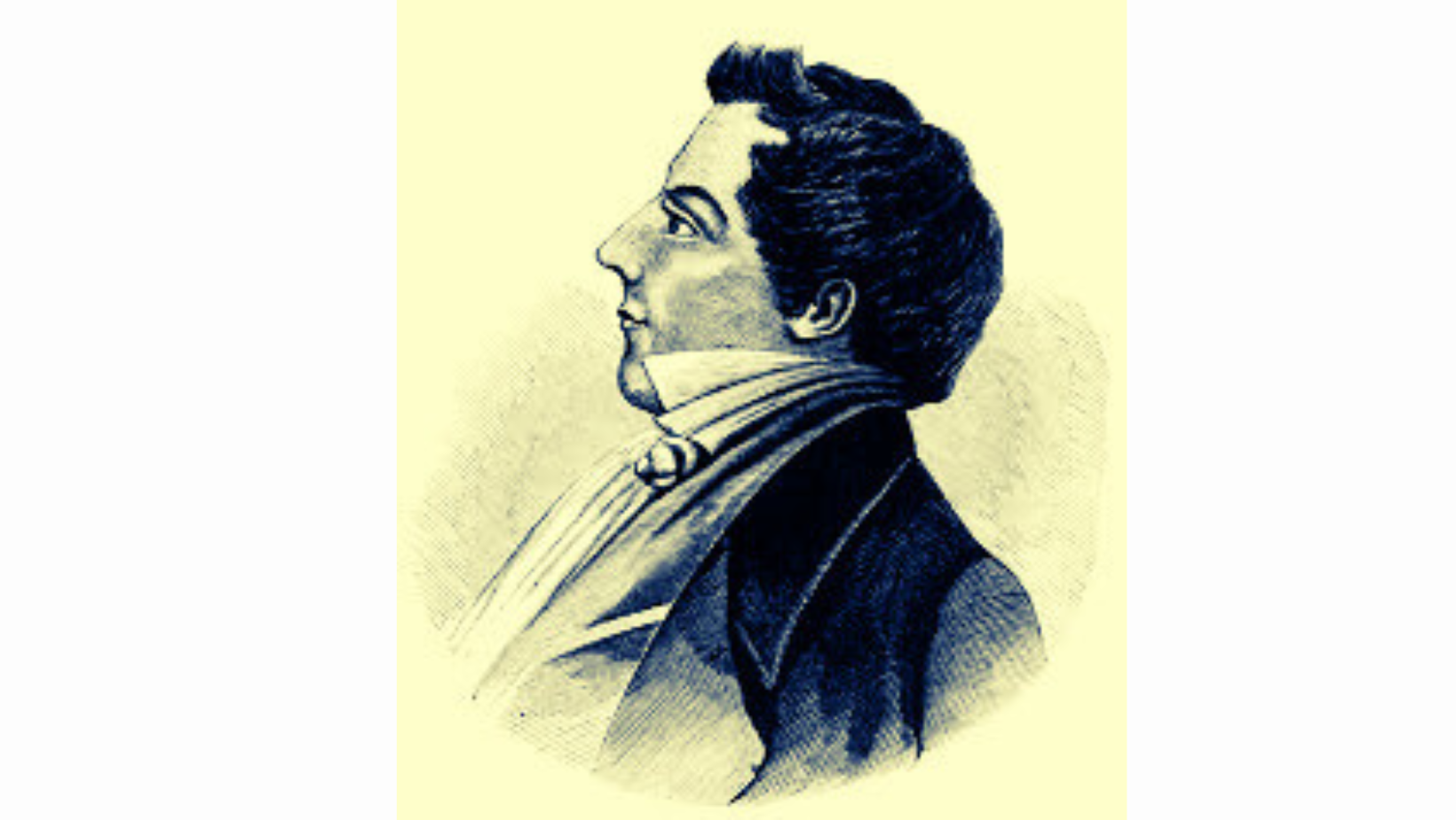
Articles/Essays – Volume 27, No. 3
One Face of the Hero: In Search of the Mythological Joseph Smith
In the spring of 1985 I received a telephone call from my local stake high councilor requesting that I give a talk to the Stake Aaronic Priesthood around a campfire at an annual stake camping trip. He wanted me to talk about Joseph Smith or the restoration of the priesthood. I accepted. At the time I was reading Richard Bushman’s Joseph Smith and the Beginnings of Mormonism with great interest and a heightened sense of the adventure of the Smith family in bringing forth the Book of Mormon.
I soon discovered that a campfire surrounded by twelve-to-eighteenyear-old boys was not the place for profound statements about the doctrines of the priesthood or the achievements of Joseph Smith. Rather I realized that adventure stories from Joseph’s life held the attention of these young men in the midst of hooting owls, a blazing fire, and thoughts of nighttime escapades.
While standing in front of a crackling fire, I told many tales, including the discovery of the golden plates, the escape from Liberty Jail, and the shootout at the martyrdom of Joseph and Hyrum. To my amazement these stories became magical spells holding the gaze of all present. I felt somehow during this ritual of storytelling that we became one organism much the same way a congregation may feel spiritual oneness during a church conference while standing in unison singing 11We Thank Thee, 0 God, for a Prophet.” Instead of producing a “near-death experience” for the Stake Aaronic Priesthood, youth as well as their leaders, by talking theology, a “near-life experience” occurred when I told stories.
That these stories had such a life-affirming effect should not have surprised me. I remember as a Mormon youth preferring story over theology. I also remember as a missionary receiving a group letter from my home ward Primary; one little girl told me to “Be sure and bring home some good missionary stories.” That telling such stories is what Mormonism at its heart may be—and should be—is further evidenced by recent papers given at Sunstone symposia: Richard Bushman’s “The Stories of Our Lives: Narrative and Belief In Mormondom” (Washington, D.C., 1990) and Eugene England’s “Book of Mormon Conversion Narratives, or Why We Should Stop Doing Theology and Tell Each Other Stories” (Salt Lake City, 1990). My purpose in this essay is to suggest one of many possible approaches to Joseph Smith and Mormonism, namely, Joseph as a faith-story Hero and as disseminator of Hero faith-stories. I rely on Joseph Campbell’s popular Jungian Hero model from The Hero with a Thousand Faces [1] with slight modifications. [2]
When I use the term “faith-story,” [3] I refer to the term “myth.” When once asked whether a myth is a lie, Joseph Campbell replied that a myth is a metaphor. [4] He explained that myth functions as a metaphor because myths are told, believed, and lived not because of their historical veracity, but because of their poetic power to reconcile us to the mysteries of existence and awaken our own inner spiritual potential. They accomplish this by explaining transcendent truths—difficult to articulate—in the form of a story and/or a ritual which is not only easy to articulate, but which explains the ineffable through tangible symbols. [5] Therefore, exploring the mythological Joseph Smith has nothing to do with proving or disproving the actual events of his historical life. Rather it has a lot to do with exploring the stories told about him and by him and their use and meanings. That Joseph is an actual historical figure should not detract from the power of the myths he lived and those told about him any more than Abraham Lincoln’s or John Kennedy’s historical reality detracts from the myths they lived and which were created from their lives. [6] I acknowledge the contributions regarding myth previously made by students of Mormon thought and history [7] and hope that my comments may further efforts to understand and appreciate the power of myth in our shared religious tradition.
Before looking at the Joseph Smith story and Mormonism as Hero myths, it is necessary to set forth the elements contained in the Campbell model of the Hero myth.
The Hero Model
Campbell summarizes the elements of the Hero myth as follows:
The standard path of the mythological adventure of the hero is a magnification of the formula represented in the rites of passage: separation—initiation—return. . . . The mythological hero, setting forth from his commonday hut or castle, is lured, carried away, or else voluntarily proceeds, to the threshold of adventure. There he encounters a shadow presence that guards the passage. The hem may defeat or conciliate this power and go alive into the kingdom of the dark (brother-battle, dragon-battle; offering, charm), or be slain by the opponent and descend in death (dismemberment, crucifixion). Beyond the threshold, then, the hero journeys through a world of unfamiliar yet strange]y intimate forces, some of which severely threaten him (tests), some of which give magical aid (helpers). When he arrives at the nadir of the mythological round, he undergoes a supreme ordeal and gains his reward. The triumph may be represented as the hero’s sexual union with the goddess-mother of the world (sacred marriage), his recognition by the father-creator (father atonement), his own divinization (apotheosis), or again—if the powers have remained unfriendly to him—his theft of the boon he came to gain (bride-theft, fire-theft); intrinsically it is an expansion of consciousness and therewith of being (illumination, transfiguration, freedom). The final work is that of the return. If the powers have blessed the hero, he now sets forth under their protection (emissary); if not, he flees and is pursued (transformation flight, obstacle flight). At the return threshold the transcendental powers must remain behind; the hero re-emerges from the kingdom of dread (return, resurrection). The boon that he brings restores the world (elixir). [8]
According to Campbell, the Hero myth awakens in listeners the untapped powers of the unconscious. The Hero represents everyone in his or her individual quest for personal identity and happiness. The Hero may in fact be an actual explorer who discovers a new world or a legendary character who discovers an imaginary world. For Campbell heroes symbolically discover the inner world of their own psyche and invite listeners to follow their own call to adventure. The Hero’s call is a call to leave the ordinary world to seek an authentic life. The trials are our inner fears of self-discovery. The boon recovered is the wholeness of our soul. Our return to the ordinary world with a self-actuated soul inspires others to make their own journey.
The Coming Forth of the Book of Mormon
The version of the story early Mormons told of the coming forth of the Book of Mormon as reconstructed by D. Michael Quinn and others [9] works as a powerful myth of the Herds journey, calling each listener on his and her own spiritual adventure. I rely on Quinn’s reconstructed version for this reason, as well as because it is probably more accurate history in most respects. Current trends in the LOS church to de-emphasize Joseph Smith [10] may reflect the inability of a de-mythologized Joseph Smith story to inspire [11] as much as reflect our attempts to placate criticisms of “Joseph worship.” Lest my essay be construed as “Joseph worship,” let me say that emphasizing the Joseph Smith story for its mythic qualities does not necessarily present a deified view of Joseph, nor does it replace the worship of Jesus Christ.
The Call to Adventure
According to the Campbell Hero model, all heroes face a moment of awesome portent in which they realize the signs of their vocation as Hero in a call to ad venture. The call to ad venture for the coming forth of the Book of Mormon is the visitation of Moroni to Joseph. On Sunday night, 21 September 1823, apparently after an unsuccessful attempt at treasure digging, Joseph prayed in his room with the express purpose to communicate with a divine messenger, perhaps using his seer stone and the Smith family magic amulets and parchments in connection with his prayer. His major concern seemed to have been to obtain forgiveness of sins, perhaps so that he might once again meet the purity standards required of a seer and thereby obtain success with another attempt to find treasure.
Joseph’s room filled with light revealing the presence of a divine being who referred to himself as Moroni. Moroni’s message, delivered three times that evening, was that Joseph had been called of God to undertake a task of tremendous importance such that his name would be had for good and ill among all nations of the earth. Joseph was called to retrieve a set of golden plates from a hill known as Cumorah [12] near his home and translate the record for the benefit of humankind. Supernatural aids were hidden with the plates to help Joseph complete the ordeal of translation. He was told he would be tempted by his own indigent circumstances and past experience to obtain the treasure for his own gain, but that he was to withstand this temptation and follow all instructions given him to obtain the plates. In vision, Joseph saw the exact spot where the plates lay in the hill.
Supernatural Aid
Heroes typically find that the gods provide them with certain unsuspected supernatural aids to assist them in their adventure. The supernatural aids unsuspected supernatural aids to assist them in their adventure. The supernatural aids given to Joseph in the pursuit of the golden plates and its translation may have been the Smith family amulets and parchments, the seer stone he had previously found while digging for a neighbor’s well, and the interpreters found with the plates. The seer stone had enabled Joseph to venture forward in his vocation as neighborhood seer and treasure hunter and thereby aided him in his quest for the golden plates.
Threshold of Adventure
The day after Moroni’s visit, Joseph went to the forested hill Cumorah he had seen in a vision and found, with the help of his seer stone, the spot where the plates were buried under a stone. Both the forest and mountains/hills are appropriate adventure encounter realms and are consistently used for that purpose in myth, according to Campbell. [13] The dark depths of forests and visionary heights of mountains and hills provide a glimpse of the risky path of the Hero into forbidden areas of the psyche and the potential vision acquired after such a quest. [14]
Road of Trials
Upon finding the location of the plates, Joseph likely drew a magic circle around the stone with the ceremonial Smith family dagger and consulted his amulets and parchments. With a long branch Joseph lifted the stone to find the golden plates glistening in a stone box along with the interpreters (Urim and Thummim), a large breastplate, the sword of Laban, and the Liahona-the holy relics of ancient Nephite kings. Joseph’s astonishment was matched only by his fear at actually uncovering such a treasure. He reached for the plates three times but was unable to grasp them. He cried out, “Why can’t I obtain this book?” Joseph had heard of the enchantment which guarded such treasures but was surprised at his inability to remove the plates. Moroni appeared suddenly from the stone box, perhaps appearing from the form of a toad or some other amphibian, [15] and shocked or struck Joseph, rebuking him for desiring the plates for riches and for failing to keep God’s commandments. [16] Campbell’s comparative mythological and dream motif analysis indicate that the toad/dragon symbol may in fact represent Joseph’s encounter with the fearful guardians of his own psychic recesses and that the golden plates as a symbol may in fact represent Joseph’s own soul potentialities which can only be obtained after surviving heroic trials. [17] Moroni also assumes a dual role of guardian presence in this story and mentor figure in successive visits to the hill.
Moroni indicated that Joseph could try to obtain the plates the same date the next year if he brought his brother Alvin with him. Joseph had failed his first trial to overcome greed, but anxiously awaited his next opportunity.
Joseph’s family believed his story and took great interest in his adventure. Joseph’s former treasure-hunting partners (Moroni had told Joseph to leave their employ) and some of his neighbors also believed his story. His older brother Alvin was especially anxious about the plates because of the role he might play in obtaining them. Two months later, however, Alvin died. His last words were to Joseph: “Do everything that lies in your power to obtain the Record. Be faithful in receiving instruction, and in keeping every commandment that is given you. Your brother Alvin must leave you.” Alvin’s loss was great because of the love the Smiths felt for him as well as the fear that Joseph, without Alvin, would not be able to pass the tests to get the plates. Joseph did not know what to do.
The next year, on 22 September 1824, Joseph returned to the hill alone. Rumors had been circulating that either the Smiths or their former treasure-hunting partners had exhumed Alvin’s remains to fulfill the requirement that Alvin be present at the next meeting with Moroni; Joseph Sr. had printed newspaper notices in an attempt to dispel that rumor and eventually opened Alvin’s grave to disprove it. Moroni asked Joseph at this 1824 meeting where Alvin was Joseph replied that Alvin was dead. Moroni then said Joseph could have the plates if he brought the right person with him next time. Joseph asked, “Who is the right person?” Moroni said, “You will know.”
On or before 22 September 1825 Joseph again attempted to get the plates by bringing a former treasure-digging partner named Samuel Lawrence. Joseph took Lawrence to the hill and determined that Lawrence was not the right person and apparently failed to visit with Moroni or obtain the plates.
The following year, on 22 September 1826, Joseph visited the hill again and Moroni told him that he had only one more chance to get the plates: he must keep the commandments and get married. Joseph looked in his seer stone and discovered that Emma Hale was the woman he was to marry and bring with him to get the plates the next year.
Meeting the Goddess
After many trials the Hero is faced with an ultimate challenge which, if resulting in triumph, enables him to return with a boon to restore the world. The ultimate challenge may take many forms, and most often results in a sacred marriage with the goddess-mother of the world, or atonement with the father-creator, or the exaltation and divinization of the Hero himself.
For Joseph’s adventure of the discovery of the Book of Mormon, his triumph could be viewed as the sacred marriage, which also takes the mythic form of bride-theft. Joseph met Emma after moving to Pennsylvania to work with Josiah Stoal’s treasure-hunting partnership and the couple fell in love. Emma’s father knew of Joseph’s treasure-digging activities and strongly disapproved of Emma’s seeing him. Joseph had turned to his treasure-digging associates to help him win Hale’s approval, but met no success. For love and to fulfill Moroni’s requirement, Joseph eloped with Emma in January 1827, risking the alienation of her parents.
Campbell has attempted to show in many myths that the sacred marriage may represent the coming to knowledge of the Hero of all things that can be known, and may be associated with the discovery of gold or other wealth. [18]
Retrieval of the Ultimate Boon
Joseph and Emma “borrowed” Joseph Knight’s wagon early on the morning of 22 September 1827 and drove to the hill. Emma stayed and prayed as Joseph climbed Cumorah and retrieved the plates. Details of this final, successful visit with Moroni are non-existent, but Joseph returned with the plates and published them to the world as the most correct book on earth with the express purpose to bring Jew, Indian, and gentile to Jesus Christ, to resolve contemporary gospel doctrine disputes, and to explain the mystery of the ruins of a once great people who anciently inhabited the Americas.
Although specifics of the last interview with Moroni are not available, details of Joseph’s return with the plates indicate the further trials he had to overcome as Hero to bring the boon of the Book of Mormon to the world. One version indicates that as he ran through the forest evil spirits tried to stop him, lashing him with tree limbs in a storm. Subsequent stories which took place during the translation process of hiding the plates from inquisitive neighbors—actually former treasure-hunting partners looking for their share in the find of the golden plates treasure—are equally as adventurous, as well as the trials of the dictation of the text and its final printing. But since these stories are generally familiar to Mormons and of less mythic appeal, I will not repeat them.
Mythical Application of the Book of Mormon Story
Non-Mormon psychologist T. L. Brink has discussed aspects of the connection of Joseph’s treasure digging with the discovery of the Book of Mormon in order to analyze Joseph’s psychological profile. His conclusions are equally as valid to explain the mythic-psychological effect of treasure digging on Joseph’s ultimate vocation as prophet. Comparing Joseph’s explorations with seer stones and treasure digging to Carl Jung’s analysis of an alchemist’s attempt to use a philosopher’s stone to change lead to gold, Brink indicates:
The gold which the alchemists sought was but a symbol of spiritual perfection which they hoped to achieve in themselves. From this perspective we may say that even if Joseph Smith had engaged in money-digging as a youth, this in no way proves him to have been an imposter. The technique of using a magic stone in order to obtain gold can be seen as a spiritual quest for perfection. Therefore, from a Jungian perspective, a young money-digger is not necessarily a swindler in the making. He may be a prophet in the making. [19]
Joseph’s experience with treasure digging and his only treasure find, the Book of Mormon, did not yield riches for the Smith family, contrary to their expectations. Joseph’s treasure-digging experiences and publication of the Book of Mormon did, however, bring spiritual wealth to the Smiths and the soon-to-be-founded Mormon church. After Joseph’s trial in 1826 for being a “disorderly person and a juggler” (under a statute similar to vagrancy statutes today which particularly included a prohibition against treasure-digging seership [20] ) Joseph and his father, Joseph Sr., lamented that young Joseph had not used his prophetic gifts for greater uses. The message of the myth seems clear: listeners may find themselves in a heroic search for the boons of the material world and yet find heretofore unexplored paths to inner spiritual growth, follow them, and find a treasure to be retrieved and shared to restore their own soul and the world.
The current use of the story of the coming forth of the Book of Mormon by Mormons is almost entirely limited to missionary discussions and history texts, albeit in biblical-rationalized terms. I do not recall hearing the story used as a faith-story or myth told in a testimony meeting to inspire the listener. As I will later discuss, the story of Joseph, the plan o.£ salvation, and the first vision are the living myths. currently told by Mormons rather than the story of the golden plates. I hope my suggestions will! enable us to use the story of the golden plates—as it appears to have been originally told—as a living myth in our faith discussions.
The First Vision as Hero Myth
The mythic potentiality of the first vision has elsewhere received significant attention and will only be briefly treated in this essay. [21] The first vision, although officially recorded in 1838 and discussed in private circles before that time, did not become a pronounced faith story told by Mormons until the 1880s. [22] My discussion does not involve a detailed account of the different versions of the vision or a harmonization [23] of them in an attempt to reconstruct the story as first told, because it was not first told by Joseph or other Mormons for its mythic appeal, and also because the story is well known and is currently used for its mythic appeal.
The first vision is typically the first story told to non-Mormons interested in joining the LOS church. It has been described as the” central means by which Joseph Smith and others explained to themselves and others ‘who we are.’ In telling this story, Joseph was acting not as historian but as myth maker.” [24] It is a shared experience by all Mormons and is used as the sacred form for Mormons in explaining their own heroic quest for truth and their adventure of faith and discovery of the treasure of testimony.
The first vision story follows the Campbell Hero pattern fairly closely. Joseph’s readings in scripture (James 1:5) and attending revivals resulted in his call to adventure. He physically separated himself to a grove of trees to pray. He was visited by an evil force which bound his tongue; presumably this trial was overcome by his faithful struggle to continue his prayer. After this initiation, Joseph was then released from the invisible force that held him and he beheld a vision of angels; including the Son and Father. Joseph experienced atonement (reconciliation) with the Father when he was told his sins were forgiven him. The ultimate boon retrieved by Joseph was the knowledge that the true church of Jesus Christ would be restored through him. Joseph then returned to the world to share the knowledge gained from this adventure of the spirit.
As I remarked earlier, new Mormon converts often narrate their conversion experience along the lines of the first vision story and see themselves as bearers of a great boon to a reluctant world. More seasoned Mormons often find that they are spiritually reawakened when they hear the new convert’s story of Hero quest and reflect on their own conversion and experience a renewal engendered by the teller of the conversion faith-story.
Joseph Smith’s Restoration as Restoration of the Hero Myth
As the work of Hugh Nibley and the FoW1dation for Ancient Research and Mormon Studies (FARMS) have documented/ the message of the Restoration as told by Joseph’s visions1 restored ancient texts1 and restored ancient rituals can be compared to similar ancient visions1 texts, and rituals with apologetic and exegetical benefits. [25] These comparisons also lend themselves to mythic analysis. Such an analysis may provide a Jungian collective unconscious framework (or some other psychological framework) for explaining the parallels and thereby negate their direct apologetic use as confirmatory evidence of Joseph’s prophetic abilities. But even Jungian psychological explanations (and perhaps others) can be harmonized with the Mormon doctrine of the pre-existence of humankind—the equivalent of the Jungian collective unconscious—and could explain the uniformity of archetypes discovered by Jung and others in all cultures. [26]
Regardless of the apologetic use of such parallels, the core faith story of Mormonism, the plan of salvation, and its ritual form, the temple endowment, follow the Campbell Hero pattern. I choose not to discuss the endowment but suggest that temple-going Mormons read Hugh Nibley’s The Message of the Joseph Smith Papyri [27] and John Lunquist’s “The Common Temple Ideology of the Ancient Near East” [28] to see the extent to which Mormon temple ritual fits the Campbell Hero pattern.
The story of the plan of salvation in narrative form can be told by nearly any child in Primary. Before we were born, we lived with heavenly parents. Our call to adventure took place in the heavenly council when we sided with Jesus and Michael against Lucifer and a third of the heavenly host. After this conflict, we left them to come to earth to undergo mortal initiation consisting of trials often caused by Satan and his followers.
Mormons have specific and general forms of supernatural aid during this quest. Aside from visions, dreams, and other experiences, we believe that our patriarchal blessings are a specific aid guiding us in our quest. The Holy Ghost is also a gift given (Campbell points this out as well [29] ) to guide us on our search for the exaltation of our soul through (a) sacred marriage, (b) personal atonement with the Father (reconciliation through repentance), and (c) resurrection after death and return to the heavenly family (apotheosis) to jointly share in exaltation’s boon.
The plan of salvation myth is clearly taught in Mormonism with the express purpose of enabling each individual to discover his or her divine nature (the call), join the community of faith (separation), and endure trials of keeping the commandments, persecution, and mortal sorrow, with the hope of a triumphant, heroic return to God’s presence.
The Life of Joseph Smith as Hero Myth
Joseph Smith’s life, a life viewed by Mormons as having been lived according to the myth of the plan of salvation, also follows the Hero path in its typical tellings.
The Hero’s call to adventure for Joseph’s life as a prophet can be viewed as the combination of his divine call in the pre-existence-as evidenced by his (a) statements, [30] (b) restored textual prophecies, [31] and (c) a family prophecy [32] plus the first vision and discovery of the golden plates.
The supernatural aid given Joseph consisted of the Holy Ghost, his seer stones/Urim and Thummim, the Smith family parchments, amulets, and other paraphernalia, and constant revelatory experiences and visitations.
The trials of Joseph are numerous and well known: his leg operation as a child; the Kirtland, Ohio, tar and feathering; the “trials of Missouri/’ specifically, Liberty Jail; false imprisonments and trials; and finally his brutal death in a Carthage, Illinois, jail.
The telling of the Joseph story also includes a meeting with the goddess and apotheosis.
While polygamy is no longer taught or sanctioned in the mainstream church, it nevertheless has current mythic meaning and potential. While polygamy has been previously viewed as having been instituted (a) by Joseph at God’s command (D&C 132), (b) by Joseph’s lust, [33] (c) by Joseph’s desire to broaden his family experience, [34] or (d) as a reaction to the breakdown of the traditional family in the nineteenth century, [35] polygamy as Joseph’s meeting with the goddess makes mythological sense as a part of his Hero quest.
In addition, the Joseph Hero cycle also includes the story of his apotheosis. Joseph died a martyr’s death and was called home again to a place where his enemies could no longer harm him. Beyond the veil, Joseph continues to lead and direct the church and sits with the exalted prophets of old. His restoration benefits us below and he continues to lead and direct above in the Kingdom of God: “Mingling with Gods he can plan for his brethren/ Death cannot conquer the Hero again.” [36]
At a minimum, I think the foregoing Hero myth analysis of Joseph Smith confirms Richard Bushman’s conclusion that “[i]n the final analysis, the power of Joseph Smith to breathe new life into the ancient sacred stories, and to make a sacred story out of his own life, was the source of his extraordinary influence.” [37] Bushman’s conclusion that “[t]he strength of the church, the vigor of the Mormon missionary movement, and the staying power of the Latter-day Saints from 1830 to the present [1984] rest on the belief in the reality of those events” is undoubtedly true, but given the phenomenon of the “closet doubter” in the church, [38] one wonders if Bushman’s observation might be broadened so that the strength of the church partially rests on the psychological response of its members to the mythic elements of the· sacred stories of Joseph Smith and the church and the mythic boon they brought to humankind as Hero. [39]
A reviewer of Dean Jessee’s compilation The Personal Writings of Joseph Smith recently commented that as a result of such fine research by Jessee and others we are now making real progress in our” search for the historical Joseph,” [40] alluding to Albert Schweitzer’s groundbreaking In Search of the Historical Jesus. Perhaps one day soon a reviewer will speak of the growing body of literature proposing mythological approaches to Joseph and Mormonism and say we are now making real progress in our “search for the mythological Joseph and his church.” At that point, our experience of Joseph’s narratives and other faith stories of our tradition will have called us to the soul’s high adventure and we will have embarked on our own spiritual heroic quest.
[1] Joseph Campbell, The Hero with a Thousand Faces (New York: Pantheon Books, 1949), hereafter Thousand Faces .
[2] Campbell’s approach is being closely examined in part because of the controversial nature of his interdisciplinary methods and conclusions. See, for instance, Daniel C. Noel, ed., Paths to the Power of Myth (New York: Crossroad, 1990). Other approaches to Hero myths include the Freudian approach, exemplified by Otto Rank in The Myth of the Birth of the Hero , trans. F. Robbins and Smith Ely Jelliffe (New York: Journal of Mental Disease Publishing, 1914), and a myth-ritualist approach exemplified by Lord Raglan, The Hero (London: Methuen, 1936), both of which have been reprinted (Raglan’s work only partially) in Robert A. Segal, ed., In Quest of the Hero (Princeton, NJ: Princeton University Press, 1990).
[3] Suggested by C. Robert Mesle, “Scripture, History and Myth,” Sunstone 4 (Mar.-Apr. 1979): 49-50.
[4] Joseph Campbell, in Phil Cousineau, ed., The Hero’s Journey: The World of Joseph Campbell (New York: Harper & Row, 1990), 134-36, hereafter Hero’s Journey.
[5] This concept can be found in virtually ail of Campbell’s works. See, for instance, Jose.ph Campbell and Bill Moyers, Tire Power of Myth (New York: Doubleday, 1988), 31, 55. Of course, other definitions of “myth” work as well and as poorly. Mircea Eliade, Otto Rank, Ernst Cassirer, Giorgio de Santillana, Hertha von Dechend, Claude Levi-Strauss, Robert Graves, Hugh Nibley, Lord Raglan, James Frazer, Sigmund Freud, Carl Jung, and Victor Turner, among others, have given varying definitions to “myth” and have different theories on the origin and function of myth.
[6] See, for example, Morton T. Kelsey, Myth, History and Faith (New York: Paulist Press, 1974), 14-34. The obvious problem with myths about historical figures is that new historical findings may undermine their mythic stature, as evidenced by the recent findings of plagiarism in Martin Luther King’s doctoral dissertation, However, such an effect reveals the concerns of Joseph Campbell that myths not be viewed as history lest they lose their life (see Thousand Faces , 249.) New historical findings which may seem unsavory from a doctrinal point of view, such as the folk magic activities of the Smith family, may nevertheless yield a more fruitful field of mythic understanding, as I attempt to demonstrate in this· essay. Mormon treatments of the Smith family folk magic have focused on presenting these incidents in a theologically acceptable way for twentieth-century Mormons by minimizing their effect on the origins of Mormonism or by explaining them as mere context. As discussed later in this essay, T. l. Brink, a non-Mormon, has suggested that Joseph’s interest in treasure digging should be seen as a positive step in his development as a prophet and search for spiritual perfection. See T. L. Brink, “Joseph Smith: The Verdict of Depth Psychology,” Journal of Mormon History 3 (1976): 73-83. See also Ronald W. Walker, “The Persisting Idea of American Treasure Hunting,” Brigham Young University Studies 24 (Fall 1984): 461-72; Marvin S. Hill, “Money-Digging Folklore and the Beginnings of Mormonism: An Interpretive Suggestion,” Brigham Young University Studies 24 (Fall 1984): 473-88; Richard Lloyd Anderson, “The Mature Joseph Smith and Treasure Searching,” Brigham Young University Studies 24 (Fall 1984): 489-560; Bushman, Beginnings , 69-78; D. Michael Quinn, Early Mormonism and the Magic World View (Salt Lake City: Signature Books, 1987).
[7] Mythological treatments of Joseph Smith’s experiences and Mormonism in general have been suggested by Jan Shipps, Mormonism: The Story of a New Religious Tradition (Urbana: University of Illinois Press, 1985); Brink, “Depth Psychology,” 73-83; James E. Faulconer, “Scripture, History and Myth,” Sunstone 4 (Mar.-Apr. 1979): 49-50; C. Robert Mesle, “History, Faith and Myth,” Sunstone 7 (Nov.-Oec.1982): 10-13; Lawrence Foster, “First Visions,” Sunstone 8 (Sept.-Oct. 1983): 39-43; and Clifton Jolley, “The Martyrdom of Joseph Smith: An Archetypal Study,” Utah Historical Quarterly 44 (Fall 1976): 329-50.
[8] Campbell, Thousand Faces , 30, 246.
[9] Unless stated otherwise, all reconstructions of the story of the coming forth of the Book of Mormon are based on Quinn’s Magic World View , 112-49. Although his work is speculative, Quinn’s reconstruction of how the early stories about the coming forth of the Book of Mormon were told (as opposed to what actually happened) are substantiated by early sources friendly to the church. Bushman argues convincingly that an accurate reconstruction of how event relating to the coming forth of Book of Mormon actually occurred is difficult. See Bushman, Beginnings , 70.
[10] See, for instance, how this trend is reflected in Dallin H. Oaks, “Witnesses of Christ,” Ensign 20 (Nov. 1990): 29-32.
[11] See Campbell’s discussion of the death of myth when viewed solely as biography in Thousand Faces , 249. Ironically, accounts told to early converts by Joseph Smith (see Dean C. Jessee, ed., “Joseph Knight’s Recollection of Early Mormon History,” Brigham Young University Studies 17 [Fall 1976]: 29-39) contained details of treasure digging and folk magic in the story of the coming forth of the Book of Mormon whereas later version by him ignored those elements or admitted them defensively. See, for example, Richard Van Wagoner and Steve Walker, “Joseph Smith: ‘The Gift of Seeing,’” Dialogue: A Journal of Mormon Thought 15 (Summer 1982): 48-68.
[12] Whether Joseph called the hill “Cumorah” has been much discussed. See William J.Hamblin’s arguments that Joseph did not identify the hill with Cumorah in “An Apologist for the Critics: Brent Lee Metcalfe’s Assumptions and Methodologies” in Review of Books on the Book of Mormon 6 (1994), 1:476-80. David Whitmer’s testimony, however, is clear that both he, Joseph, and Oliver Cowdery met Moroni on the road to Payette where Moroni said he was “going to Cumorah” in the direction of the hill where the plates were found. See the interviews cited by Milton V. Backman, Jr., in Eye-Witness Accounts of the Restoration (Salt Lake City: Deseret Book Co., 1986), 120.
[13] See, for instance, Campbell, Thousand Faces , 43; Campbell, Hero’s Journey , 11-12.
[14] Campbell, Hero’s Journey , 8-12.
[15] That the so-called “Salamander Letter” is a Mark Hofmann forgery does not change the detail of the amphibian as shown by Quinn, Magic World View , 128n5.
[16] Other accounts indicate that Joseph was able to lift the plates from the stone box, but that after placing them to the side of the box, he looked into the box for additional treasure and found that the plates had disappeared. Moroni told him then that because he had disobeyed the commandment to not lay down the plates and because of his greed, the plates would not be delivered to him and he would have to wait another year to receive them. Quinn, Magic World View , 123-24.
[17] See Campbell, Thousand Faces , 51-53. Others have also indicated that the golden plates and the Boole of Mormon both may represent spiritual ideals as mere objects, regardless of the reality, content, or historicity of the text. See, for instance, A. Bruce Lindgren, “Sign or Scripture: Approaches to The Book of Mormon,” in Dan Vogel, ed., The Word of God: Essays on Mormon Scripture (Salt Lake City: Signature Books, 1990)
[18] See Campbell, Thousand Faces , 116. Although Campbell deals mainly with male heroes, the sacred marriage may also represent the same coming to knowledge for females as well as males.
[19] Brink, “Depth Psychology,” 80.
[20] See, for instance, Wesley P. Walters, Joseph Smith’s Bainbridge, N. Y. Court Trials (Salt Lake City: Utah Lighthouse Ministry, n.d.).
[21] See, for instance, Mesle, “History, Faith and Myth,” 13; Shipps, Mormonism , 32; and James B. Allen, “Emergence of a Fundamental: The Expanding Role of Joseph Smith’s First Vision in Mormon Religious Thought,” Journal of Mormon History 7 (1980): 43-61.
[22] Allen, “First Vision.”
[23] l will use details from each of the different versions in my discussion. The different accounts are readily available. See, for instance, Dean C. Jessee, “Early Accounts of the First Vision,” Brigham Young University Studies 9 (Spring 1969): 275-95,
[24] Mesle, “History, Faith and Myth,” 13.
[25] See, for instance, Hugh W. Nibley [Stephen D. Ricks, ed.], Enoch thee Prophet (Salt Lake City: Deseret Book Co., 1986); and C. Wilfred Griggs, “The Book of Mormon as an Ancient Book,” in Noel B. Reynolds, ed., Book of Mormon Authorship (Salt Lake City: Bookcraft, 1982), 75-101.
[26] Other approaches to myth may shed further light on these issues. Structural approaches, as developed by Claude Levi-Strauss and others, may suggest that the Restoration through Joseph Smith of ancient narratives and ritual is a restoration of mythemes that reconcile the same binary opposite phenomena that were reconciled anciently; even though the ancient narratives and rituals may or may not have formal correspondence with the narratives and ritual restored through Joseph.
[27] Hugh Nibley, The Message of the Joseph Smith Papyri: An Egyptian Endowment (Salt Lake City: Deseret Book Co., 1975).
[28] In Truman G. Madsen, ed., The Temple in Antiquity (Salt Lake City: Bookcraft, 1984), 53-76.
[29] Campbell, Thousand Faces , 72-73.
[30] See Andrew F. Ehat and Lyndon W. Cook, eds., The Words of Joseph Smith: The Contemporary Accounts of the Nauvoo Discourses of the Prophet Joseph (Provo, UT: BYU Religious Studies Center, 1980).
[31] Both the Book of Mormon and Joseph’s inspired revision of the Bible contain prophecies about the rise of a prophet named Joseph. See 2 Ne. 3:5-16; JST Gen. 50:26-36.
[32] Brigham H. Roberts, ed., The History of the Church (Salt Lake City: Deseret Book Co., 1978), 2:443.
[33] See Fawn M. Brodie, No Man Knows My History: The Life of Joseph Smith, the Mormon Prophet (New York: Alfred A. Knopf, 1945).
[34] Brink, “Depth Psychology,” 82.
[35] See Lawrence Foster, Religion and Sexuality (Urbana: University of Illinois Press, 1984).
[36] W. W. Phelps, “Praise to the Man,” no. 27, Hymns of the Church of Jesus Christ of Latt.er-day Saints (Salt Lake City: Deseret Book Co., 1985).
[37] Bushman, Beginnings , 188.
[38] See D. Jeff Burton, “The Phenomenon of the Closet Doubter,” Sunstone 7 (Sept.-Oct. 1982): 34-38.
[39] Although most Mormons and non-Mormons tend to accept or reject the Joseph Smith story based solely on empirical/ historical grounds, many rank-and-file Mormons I have known appear to have an unarticulated mythic sense of his story and yet use orthodox language when discussing it even though they do not have a conventional “testimony” of the reality of Smith’s experiences. Whether Mormon general authorities respond or have responded in a mythic manner while nevertheless maintaining a more orthodox posture is more difficult to determine. Although a matter of controversy, B. H. Roberts apparently came to view his belief in the Book of Mormon and Joseph Smith’s production of it in a mythic sense as a psychological event of profound reality, although perhaps non-historical See Brigham D. Madsen, ed., Studies in the Book of Mormon (Urbana: University of Illinois Press, 1985), 23-24. Similarly, while discussing the Book of Abraham with Thomas Ferguson1 Apostle Hugh B. Brown is reported to have agreed with him regarding the non-historical nature of that book, evidently revealing a possible mythic interpretation of it. See Stan Larson, “The Odyssey of Thomas Stuart Ferguson,” Dialogue: A Journal of Mormon Thought 23 (Spring 1990): 55-93.
[40] See the review of Marvin S. Hill in Brigham Young University Studies 25 (Summer 1985): 117-25.
- Related Topics
- Joseph Smith

Lesson 7: Joseph Smith – Josephite Seer & Voice of the Lord (For Our Day)
Answer the Call
Lesson 7: 2 nephi 3–5 joseph smith: josephite seer & voice of the lord.
Set the Course
In 2 Nephi 3 , we find prophecies given by Joseph of Egypt and Lehi regarding their posterity in the last days. This revelation emphasizes Joseph Smith’s prophetic mission to bring forth the word of God in our day. In the words of Elder Bruce R. McConkie:
When Joseph Smith spoke by the power of the Holy Ghost, it was as though the Lord Jesus Himself was saying the words. The Prophet’s voice was the voice of the Lord; he was not perfect; only Christ was free from sin and evil. But the Prophet was as near perfection as mortals can get without being translated. He was a man of such spiritual stature that he reflected the image of the Lord Jesus to the people. His voice was the voice of the Lord. Bruce R. McConkie
Currently among Latter-day Saints, there is a great contention about how we should view Joseph Smith. An increasing number are voicing their feelings that the Prophet should be taken off of the pedestal to which he has been placed by early Church members and leaders, although they were those who knew him best. The Joseph Smith Foundation has put together a list of statements by latter-day prophets who testified of the Prophet’s greatness.
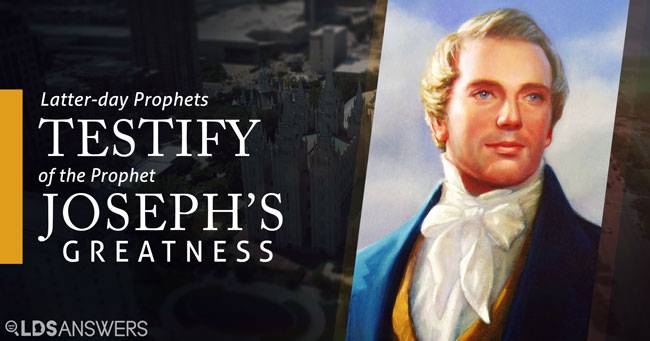
Read this inspiring compilation of testimonies here!

Defending the Prophet Joseph Smith
The character and mission of the Prophet Joseph is under heavy attack in our day. However, real facts and history support the Restoration! Equip yourself and your children to answer hard faith crisis questions in our day through the following resources!
Was Joseph Smith involved in treasure digging?
Mark Hofmann, Leonard Arrington and the New Progressive Narrative
Debunking Rough Stone Rolling (Part 1)
Debunking Rough Stone Rolling (Part 2)
Debunking the claim Joseph Smith was involved in ritual magic and treasure digging!
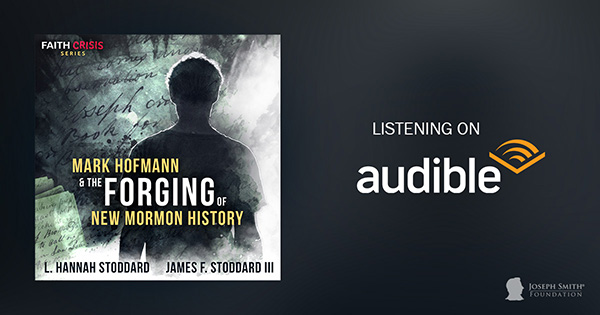
Joseph Smith Delivers the Word of God
On the day the Church was organized, the Lord gave a revelation to stand as the charter of the Church, commanding the members and leaders—both present and future—to “give heed unto all his [Joseph Smith’s] words and commandments which he shall give unto you,” promising that if the counsel was followed, “the gates of hell shall not prevail against you; yea, and the Lord God will disperse the powers of darkness from before you, and cause the heavens to shake for your good, and his name’s glory.” (Doctrine and Covenants 21:6)
Elder Bruce R. McConkie explained that while we have successive presidents of the Church and other apostles, the Prophet Joseph Smith’s words stand preeminent, and that we should regard every other leader as a mere echo of Joseph Smith.
Every dispensation head is a revealer of Christ for his day . . . and every other prophet or apostle who comes is a reflection and an echo and an exponent of the dispensation head. All such come to echo to the world and to expound and unfold what God has revealed through the man who was appointed to give his eternal word to the world for that era. Such is the dispensation concept. Bruce R. McConkie, “This Generation Shall Have My Word through You,” General Conference , June 1980.
In an interview with David Ransom on November 9, 1997, President Gordon B. Hinckley explained,
. . . we have a great body of revelation, the vast majority of which came from the prophet Joseph Smith. We don’t need much revelation. We need to pay more attention to the revelation we’ve already received. Now, if a problem should arise on which we don’t have an answer, we pray about it, we may fast about it, and it comes . . . we don’t need a lot of continuing revelation. We have a great, basic reservoir of revelation. Gordon B. Hinckley, “ Sunday Interview — Musings of the Main Mormon ,” interview by Don Lattin, SFGATE , April 13, 1997.
During a Christmas devotional on December 7, 2003, he again reiterated,
I look to [Joseph Smith]. I love him. I seek to follow him. I read his words, and they become the standards to be observed in guiding this great Church as it moves forward in fulfilling its eternal destiny. Gordon B. Hinckley, First Presidency Christmas Devotional, December 7, 2003, The Church of Jesus Christ of Latter-day Saints.
The institution that Joseph Smith restored, using the keys and authority given to him by God, was both true and living. While no leader or member of the Church is perfect or inerrant, to the degree that the teachings and revelations of Joseph Smith are followed, we have the divine promise that we will continue to experience success in our efforts.
Teachings of Joseph Smith Compilation
We live in a day where many are frightened for the future. Our liberty is being lost, our families are falling apart, addiction is increasing, and the economy is precariously hanging by a thread, while wars and rumors of wars, plagues, and natural disasters flash across the news headlines daily. Are the gates of hell prevailing? And yet the Lord provided a simple forgotten key, a solid ANSWER that would allow the Latter-day Saints to weather the storms that lay ahead:
Wherefore, meaning the church, thou shalt give heed unto all his [Joseph Smith’s] words and commandments which he shall give unto you as he receiveth them, walking in all holiness before me; For his [Joseph Smith’s] word ye shall receive, as if from mine own mouth, in all patience and faith. For by doing these things the gates of hell shall not prevail against you; yea, and the Lord God will disperse the powers of darkness from before you, and cause the heavens to shake for your good, and his name’s glory. Doctrine and Covenants 21:4-6
In response to the Lord’s promise in Section 21 of the Doctrine and Covenants, a number of families have recently been studying the teachings of Joseph Smith—working as families to organize his teachings by topic—and the results have been life changing!
One young mother of four shared her experience as a volunteer:
There is no earthly way to express or explain how being immersed in this project has blessed our home the last few months. Not just blessed but has completely changed us from the inside out. My children's and mine and my husband's hearts are changing right before our eyes. If you have wayward or apathetic children or are looking to strengthen a marriage—get into these teachings. This is truly a turning of the hearts to our fathers. I honestly believe if you're not having your children or yourselves immersed in the teachings of the Prophet Joseph Smith and the early saints of the Restoration—whether it's this project or not—you are robbing you and your children, and you are robbing your home of the most beautiful change and conversion I've witnessed. I just have to share this testimony.
The Joseph Smith Foundation has also begun publishing this comprehensive collection of all Joseph Smith’s teachings (The Complete Teachings of Joseph Smith), organized conveniently by topic!

Joseph Smith & Isaiah
As part of the Simplifying Isaiah series produced for Lesson 5 ( 1 Nephi 20-22 ), a large section is dedicated to the prophecies of Joseph Smith in Isaiah 48-49 . Watch below!
Embark on the Journey
Monthly “I Am a Latter-day Nephite” Theme!
I will covenant to maintain our rights and our religion.
- If this is your first week here, welcome! Please review our “Welcome & How to Join the Quest” for some helpful information on how to use this resource. You may also want to check out the Embark on the Journey section of Lesson 1 for some activities that will be helpful in getting you started on this quest. In particular, you’ll want a journal, and perhaps the “I Am a Latter-day Nephite” resolution and a fun Book of Mormon reading chart. If desired, just start where you are in the year—don’t feel like you have to backtrack and do every lesson, but grab these helpful tools and you’ll be good to go from here!
- What have been your thoughts and views on Joseph Smith in the past, both as a man and a prophet? Have you heard any of the narratives that have circulated in recent years that suggest he was not of the most upstanding character? How do those ideas make you feel? Do you know anyone who has struggled with their faith as a result of exposure to these ideas? As you seek the Spirit, who will testify of truth, record in your journal or discuss these questions with your family.
- Read Doctrine and Covenants 135 , which is the announcement of Joseph and Hyrum Smith’s martyrdom and contains a summary of Joseph’s life and legacy. Take a moment to reflect on what you hope others will say about you when you have passed on and the legacy that you hope to leave behind. If you’d like, you can even write your own obituary and set goals on what you can start or stop doing now to become the person that you hope to be remembered as.
- Watch “My Servant Joseph” by Latter Day Kids. Discuss with your kids how Joseph was a child just like them, but grew up to do great things. Invite them to set a goal that will help prepare them for the work that God has prepared for them, even if they don’t know what it is right now.
- Joseph Smith was 14 when he received the First Vision. Joseph of Egypt was 17 when he was sold into Egypt by his brothers. Mary was likely a teenager when she conceived and bore the Son of God, and Mormon was 15 when he saw Jesus Christ and was made the leader of the Nephite army. Likewise, Esther, the two thousand stripling warriors, David, Daniel, Nephi, and others were teenagers when they were called of God to do amazing things! In Joseph Smith – History 1:41 , Joseph records that the angel Moroni quoted Joel 2:28-32 and said that it was soon to be fulfilled. Discuss with your youth what their potential is. Invite them to consider that they can begin participating in the “great and marvelous” work right now , just as many faithful teens have done in the past. You can do this in conjunction with the family home evening/fireside activity in the “All Hands on Deck” section of this lesson.
- Choose a topic that you would like to study more about and look for quotes from Joseph Smith and other early church leaders on that topic. Some websites to help include Complete Teachings of Joseph Smith , Scriptural Teachings of the Prophet Joseph Smith , and Scripture Citation Index .
- If you have chosen to download or purchase a designed cardstock version of the “I’m a Latter-day Nephite” resolution, you may want to post it where you will see it every day—on the fridge or your mirror, for example. Ponder on this month’s statement “I will covenant to maintain our rights and our religion.”
Read “Gospel Topic: Citizenship.” Discuss with your family or record in your journal what it means to maintain your rights. How do you contribute to ensuring that those rights remain available to you and others? Do you participate in civic duties? Why or why not?
Unless otherwise stated, reference to any products, services, hypertext link to third parties or other information by trade name, trademark, supplier or otherwise does not constitute or imply its endorsement or sponsorship by us. They are for convenience only.
All Hands on Deck
- Pray each morning this week for the Lord to give you an opportunity to share your thoughts with someone on the Book of Mormon and/or what you’ve learned this week.
- Join the For Our Day community on social media for uplifting shareable content, ideas on how to implement For Our Day in your home and classes, and to connect with others on the journey. You can find us here: Facebook , Instagram , and YouTube .
- The Complete Teachings of Joseph Smith compilation will be a blessing and shine light in a darkening world. This is a work in progress, and the Joseph Smith Foundation needs help with it! Consider gathering your friends and family and giving some of your time and talents to this work!
- Share your testimony of Joseph Smith with someone you know or on social media. Be sure to add #ForOurDay so we can find you!
- Hold a family home evening or fireside in your home for youth in your ward or even just your children and their friends. Watch the “Hope of Israel Broadcast” by President and Sister Nelson and discuss your potential and ability to do great things now. Refer to the youth activities in the “Embark on the Journey” section of this lesson for more discussion ideas.
Find the Treasure
Content coming soon!
Did you enjoy this lesson? Give us feedback to improve future courses!

Explore our newest project!
For our day: prophetic parallels in the book of mormon.
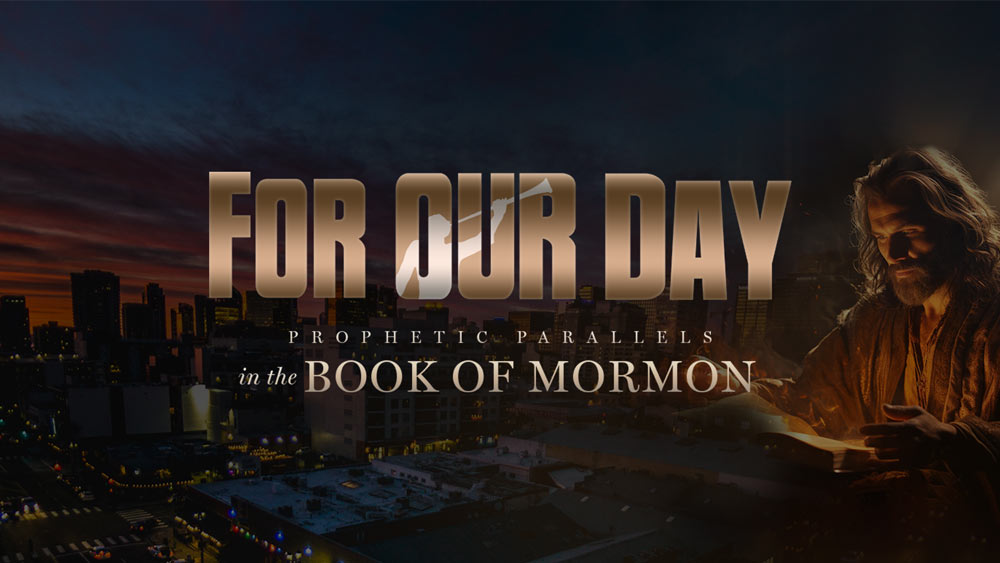
Unlock a treasure trove of FREE resources! Dive into engaging videos, lesson plans, activities, and much more—all perfectly aligned with Come Follow Me 2024.

New painting celebrates the Book of Mormon translation!
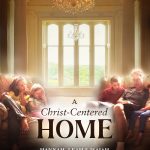
New book! A Christ-Centered Home: Hope & Healing for Every Family in Every Situation

Book release! Joseph Smith’s Plural Wives, Volume 1: Helen Mar Kimball
Vision in Light of the Restoration
801-653-9909
- Documentaries
- Journal of Discourses
- Church History
- Book of Mormon
- Culture Standards
- Learn about Joseph Smith
Free Resources
The maps in this section include many of the places mentioned in the Joseph Smith Papers and can help readers visualize the locations that were significant places in Joseph Smith’s life and the early years of the Latter-day Saint movement.
The first section includes the travel and missions of JS; the other sections correspond to the various areas where Joseph Smith lived: Western New York and Northern Pennsylvania, Ohio, Missouri, and Illinois and Iowa Territory, as well as maps of the United States in the 1830s and 1840s. Geographical names, borders, and watercourses appear as they existed in the time period given in the map titles. For more information about geographical locations, see the Places page.
Travel and Missions
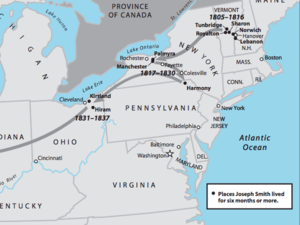
Joseph Smith’s Residences
Joseph Smith’s major places of residence and the general direction of his migrations.
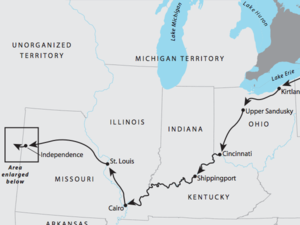
Mission to the Indians, 1830–1831
Oliver Cowdery, Peter Whitmer Jr., Ziba Peterson, and Parley P. Pratt departed New York in October 1830 on a mission to preach to the “Lamanites” in Indian territory. Frederick G. Williams joined the group in Ohio. They preached to the Indians in early 1831, but they were soon ordered off Indian land.
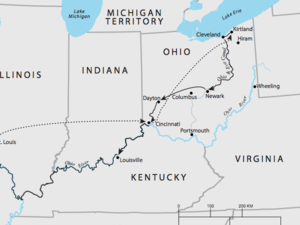
Joseph Smith’s Travel between Ohio and Missouri, 1831
In accordance with instructions in a June 1831 revelation, Joseph Smith and several others traveled from Kirtland, Ohio, to Jackson County, Missouri, where a new revelation designated Independence as the “centre place” of the city of Zion.
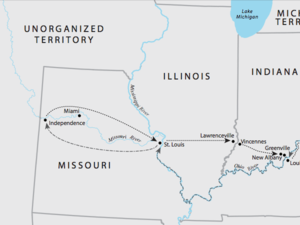
Joseph Smith’s Travel between Ohio and Missouri, 1832
In accordance with instructions in a March 1832 revelation, Joseph Smith, Sidney Rigdon, and Newel K. Whitney traveled from Hiram, Ohio, to Independence, Missouri, to counsel with church leaders.
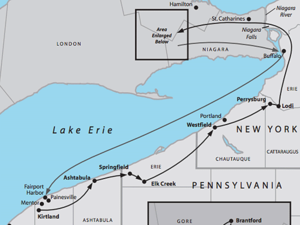
Joseph Smith’s Proselytizing Mission, October–November 1833
In the fall of 1833, Joseph Smith and Sidney Rigdon traveled with church member Freeman Nickerson from Kirtland, Ohio, to Mount Pleasant, Upper Canada.
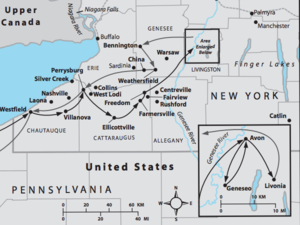
Joseph Smith’s Recruiting Mission, February–March 1834
In early 1834, Joseph Smith and Parley P. Pratt traveled from Kirtland, Ohio, to western New York to enlist recruits and raise funds for an expedition to help exiled Latter-day Saints reoccupy their lands in Jackson County, Missouri.
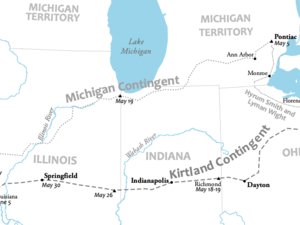
Camp of Israel Route, May–June 1834
In May and June 1834, the Camp of Israel traveled to Missouri to assist the Saints who had been driven from Jackson County, Missouri.
United States
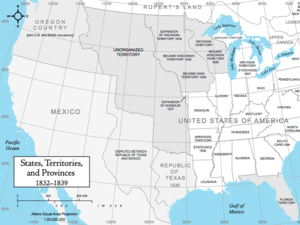
States, Territories, and Provinces, 1832–1839

Eastern United States, 1833–1834
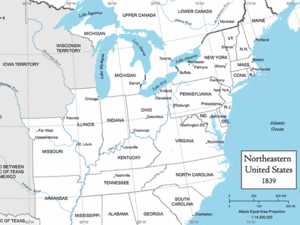
Northeastern United States, 1839

Northeastern United States, 1843
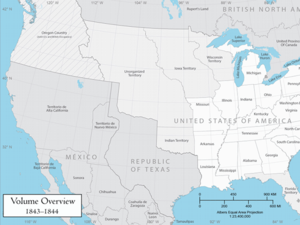
United States, 1843–1844
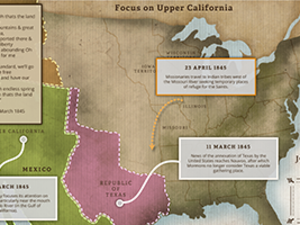
Maps Exploring Possible Latter-day Saint Settlement Sites
New York and Pennsylvania
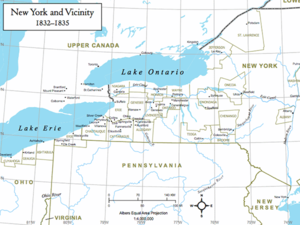
New York and Vicinity, 1832–1835
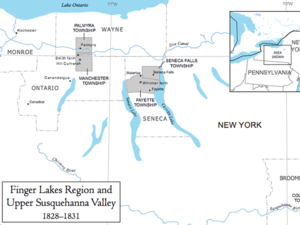
Finger Lakes Region and Upper Susquehanna Valley, 1828–1831
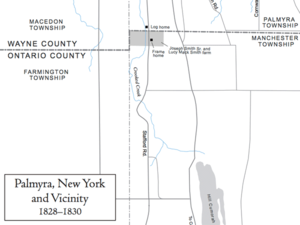
Palmyra, New York, and Vicinity, 1828–1830
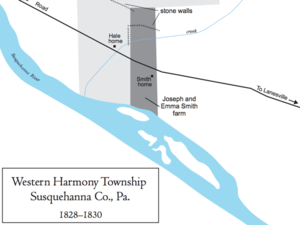
Western Harmony Township, Susquehanna County, Pennsylvania, 1828–1830
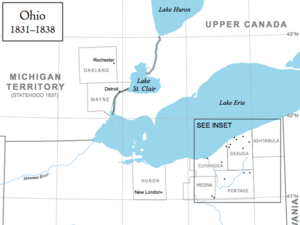
Ohio, 1831–1838
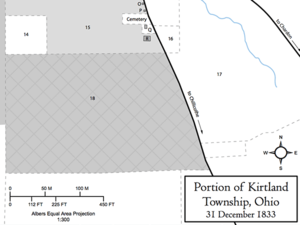
Portion of Kirtland Township, Ohio, 31 December 1833
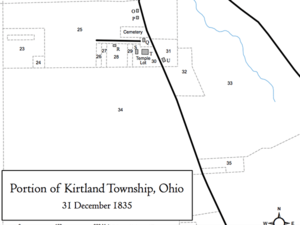
Portion of Kirtland Township, Ohio, 31 December 1835
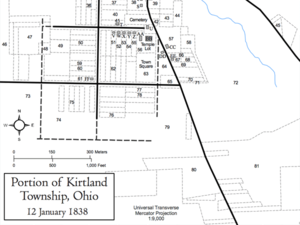
Portion of Kirtland Township, Ohio, 12 January 1838
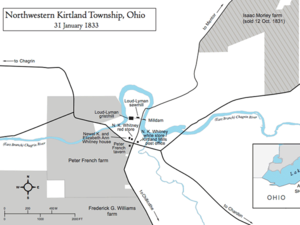
Northwestern Kirtland Township, Ohio, 31 January 1833
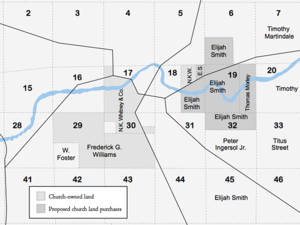
Church Landholdings in Kirtland, Ohio, circa July 1833
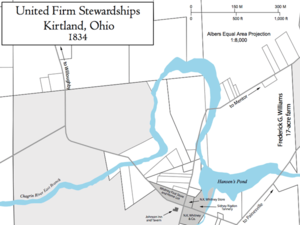
United Firm Stewardships, Kirtland, Ohio, 1834
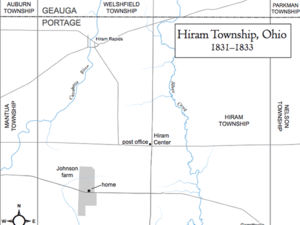
Hiram Township, Ohio, 1831–1833
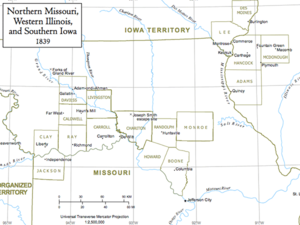
Northern Missouri, Western Illinois, and Southern Iowa, 1839
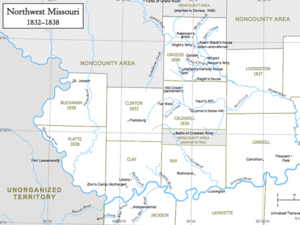
Northwest Missouri, 1832–1838
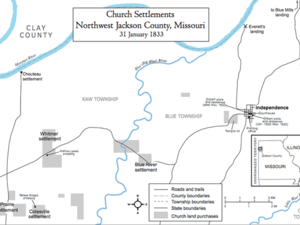
Church Settlements, Northwest Jackson County, Missouri, 31 January 1833
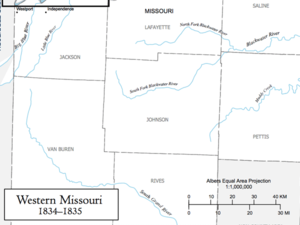
Western Missouri, 1834–1835
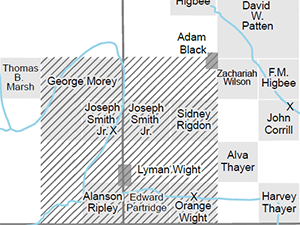
Latter-day Saint Land Claims in the Vicinity of Adam-ondi-Ahman
Illinois and Iowa Territory
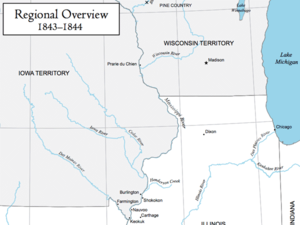
Illinois and Surrounding Area, 1843–1844
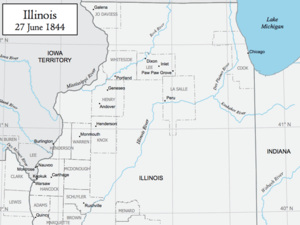
Illinois, 27 June 1844
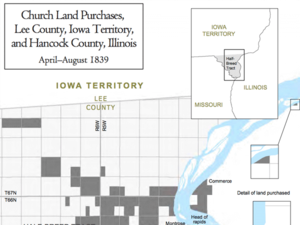
Church Land Purchases, Lee County, Iowa Territory, and Hancock County, Illinois, April–August 1839
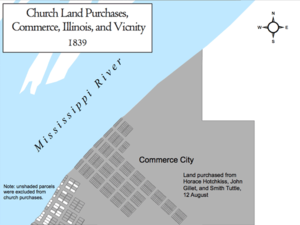
Church Land Purchases, Commerce, Illinois, and Vicinity, 1839
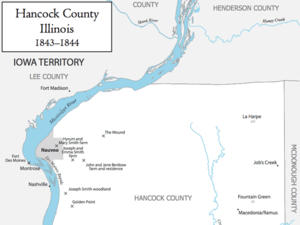
Hancock County, Illinois, 1843–1844
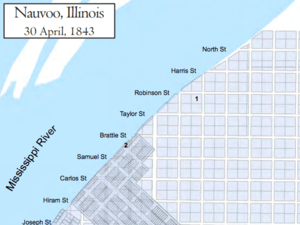
Nauvoo, Illinois, 30 April 1843
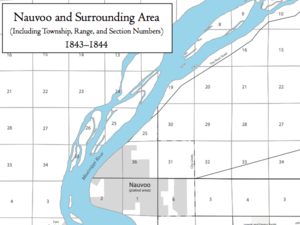
Nauvoo and Surrounding Area, 1843–1844
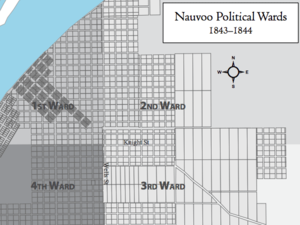
Nauvoo Political Wards, 1843–1844
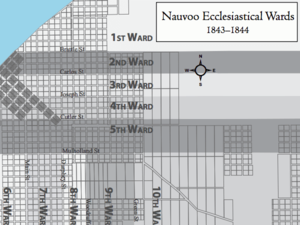
Nauvoo Ecclesiastical Wards, 1843–1844
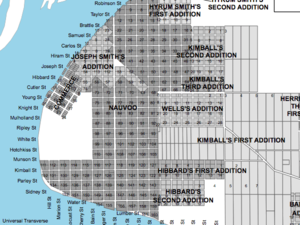
Nauvoo Plats, Blocks, and Lots, 31 August 1842
Request for Documents
Do you know of any Joseph Smith documents that we might not have heard about? Tell us
The Church Historian’s Press is an imprint of the Church History Department of The Church of Jesus Christ of Latter-day Saints, Salt Lake City, Utah, and a trademark of Intellectual Reserve, Inc.
© 2024 by Intellectual Reserve, Inc. All rights reserved. Terms of Use Updated 2021-04-13 Privacy Notice Updated 2021-04-06
- History Classics
- Your Profile
- Find History on Facebook (Opens in a new window)
- Find History on Twitter (Opens in a new window)
- Find History on YouTube (Opens in a new window)
- Find History on Instagram (Opens in a new window)
- Find History on TikTok (Opens in a new window)
- This Day In History
- History Podcasts
- History Vault
This Day In History : February 4
Changing the day will navigate the page to that given day in history. You can navigate days by using left and right arrows
Latter-day Saints begin exodus to Utah

Their leader assassinated and their homes under attack, the members of the Church of Jesus Christ of Latter-day Saints (also known as Mormons) of Nauvoo, Illinois , begin a long westward migration that eventually brings them to the valley of the Great Salt Lake in Utah .
The members of the Church of Jesus Christ of Latter-day Saints had been persecuted for their beliefs ever since Joseph Smith founded the church in New York in 1830. Smith’s claim to be a modern-day prophet of God and his acceptance of polygamy proved controversial wherever the Latter-day-Saints attempted to settle. In 1838, Smith set up a new spiritual colony in Missouri, but by 1839, anti-Mormon prejudice there had proved too virulent. The Latter-day-Saints next set up camp in Nauvoo, Illinois but prejudice followed them there as well. Angry mobs murdered Smith and his brother in June 1844 and began burning homes and threatening members of the group.
Convinced that the Latter-day-Saints would never find peace in the United States, Smith’s successor, Brigham Young , made a bold decision: the Latter-day-Saints would move to the still wild territories of the Mexican-controlled Southwest. Young had little knowledge of the geography and environment of the West and no particular destination in mind, but trusting in God, he began to prepare the people of Nauvoo for a mass exodus.
On this day in 1846, Young abandoned Nauvoo and began leading 1,600 Latter-day-Saints west across the frozen Mississippi in subzero temperatures to a temporary refuge at Sugar Creek, Iowa . Young planned to make the westward trek in stages, and he determined the first major stopping point would be along the Missouri River opposite Council Bluffs. He sent out a reconnaissance team to plan the route across Iowa, dig wells at camping spots, and in some cases, plant corn to provide food for the hungry emigrants. The mass of Latter-day-Saints made the journey to the Missouri River, and by the fall of 1846, the Winter Quarters were home to 12,000 Latter-day-Saints.
After a hard journey across the western landscape, Young and his followers emerged out onto a broad valley where a giant lake shimmered in the distance. With his first glimpse of this Valley of the Great Salt Lake, Young reportedly said, “This is the place.” That year, some 1,600 people arrived to begin building a new civilization in the valley. The next year, 2,500 more made the passage. By the time Young died in 1877, more than 100,000 people were living in the surrounding Great Basin, the majority of them Latter-day-Saints.
Young, however, had not escaped the troubles that plagued the Church in the East. By early 1848, the Latter-day-Saints’ haven became a U.S. territory after the American victory in the Mexican War. The Latter-day-Saints had finally found a permanent home along the Great Salt Lake, but its isolation and freedom from persecution was short-lived.
Also on This Day in History February | 4
Tony dungy becomes first black head coach to win a super bowl, "the sims" launches, amadou diallo killed by police, facebook launches, civil rights icon rosa parks is born.
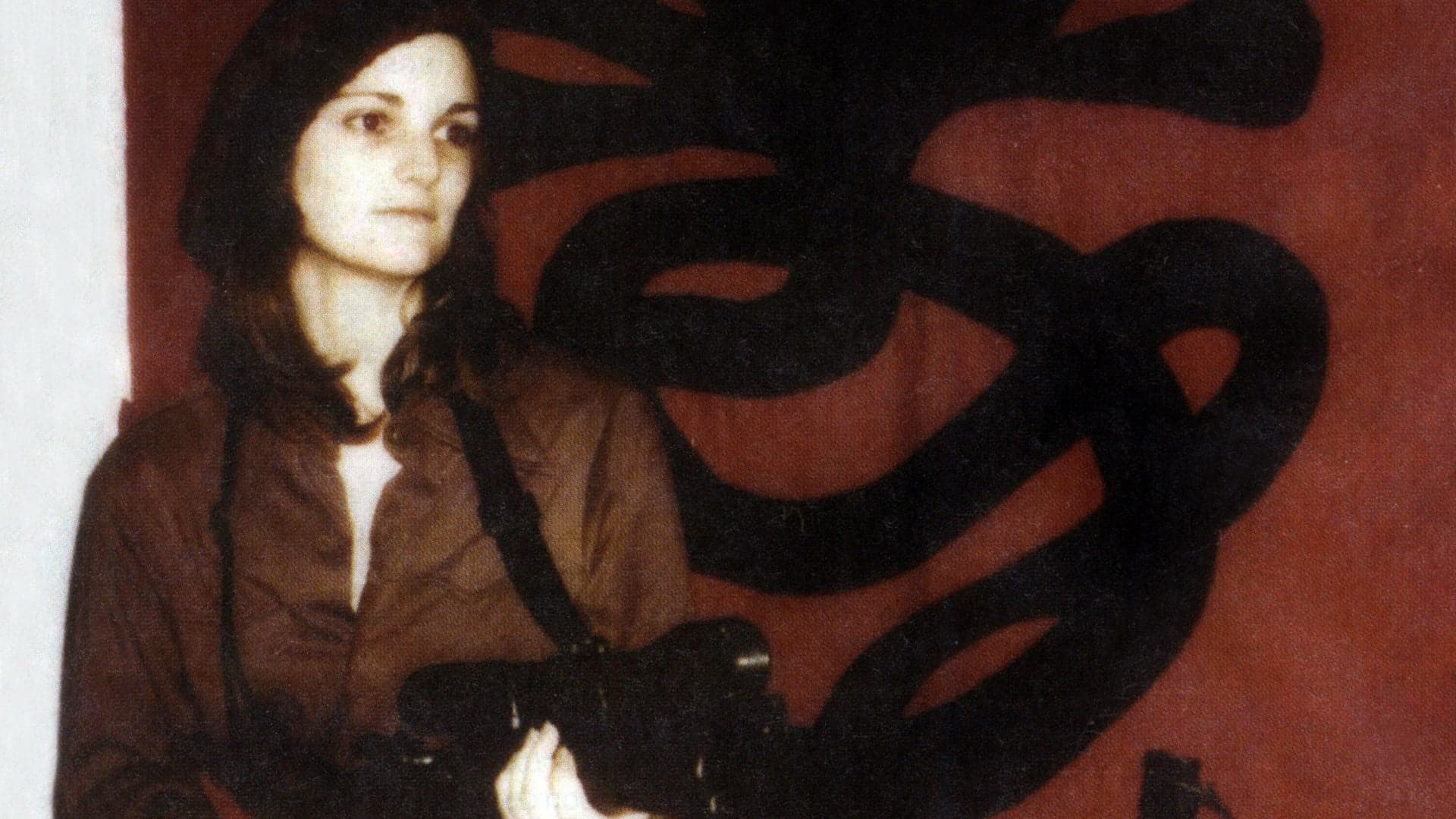
This Day in History Video: What Happened on February 4

Wake Up to This Day in History
Sign up now to learn about This Day in History straight from your inbox. Get all of today's events in just one email featuring a range of topics.
By submitting your information, you agree to receive emails from HISTORY and A+E Networks. You can opt out at any time. You must be 16 years or older and a resident of the United States.
More details : Privacy Notice | Terms of Use | Contact Us
States meet to form Confederacy
George washington unanimously elected first u.s. president, patty hearst kidnapped by the symbionese liberation army, germany declares war zone around british isles, first u.s. helicopter is shot down in vietnam, “the last of the mohicans” is published, singer-songwriter karen carpenter dies, disney releases “snow white and the seven dwarfs”, yalta conference foreshadows the cold war.
My shopping cart
Your cart is currently empty.
Sign up for our Newsletter
Sign up for our mailing list to receive new product alerts, special offers, and coupon codes. You'll save 10% on your order!
Joseph Smith: The Journey of a Prophet
Author: Susan Evans McCloud
Read a Sample Here
Author: S usan Evans McCloud is a prolific and versatile writer, with over fifty published books that range from historical fiction to mystery, nonfiction, and children’s literature. She writes her own column for Deseret News and has created many programs and songs for the Church’s Young Women, seminary, genealogy, and other programs. She is poetic yet precise in her writing and research and offers outstanding examples of literature at its best. She is also the author of two of our most beloved hymns, “Lord, I Would Follow Thee” and “As Zion’s Youth.”
This is a biographical book on The Prophet Joseph Smith, with intentional insight into his family and background, his struggles and theirs, and the way in which is experienced and developed a relationship with God and the Savior. It also stresses and illuminates his Christ-like nature, his love, gentleness, compassion and forgiveness of all men, and the way in which all men, women, and children were drawn to him--because of his purity and goodness.
- Tags: LDS LDS Reference
Related Products
You might also be interested in these items.

Dear Divine Daughter

I Will Be What I Believe Song Downloads

Visions of Glory - 5-Year Anniversary Edition

The Pearl of Great Price Made Easier
© 2024 Cedar Fort Publishing & Media | Shopify Theme by Mile High Themes | Powered by Shopify
Net Orders Checkout
Shipping address, shipping methods.
Joseph Smith’s First Journal
Lost sermons.
Prophet’s Record Keeping Began with Simple Volume
Joseph Smith began keeping a personal record a month before he turned 27. His first journal, a small volume that documents November of 1832 through December of 1834 in a little over a hundred pages, is one of the priceless treasures preserved in the Church History Library in Salt Lake City. While Joseph kept this journal only sporadically, turning much of the responsibility of record keeping over to scribes, the little book opens a window into the Prophet’s personality and is an important record of Church activities.
Joseph purchased that first journal, measuring roughly four inches wide by six inches high, on November 27, 1832. 1 Whereas a larger book would have lent itself to the creation of formal records, perhaps kept at a desk, the book Joseph bought that day could be carried in a pocket. Indeed, the journal accompanied Joseph on two missions that are described in its pages, and it was likely brought on other journeys. Three leather loops on the outside meant the journal could be fastened shut by closing the covers and inserting a pencil through the loops. The front and back covers were decorated with paper dyed in a marble pattern. The colors have faded over time, but in Joseph’s day the vibrant blue in the pattern would have stood out.
The immediate impetus for beginning the journal may have been a revelation Joseph recorded the day he bought the book. The revelation, documented in a November 27 letter from the Prophet to William W. Phelps, explained that the “duty of the Lord’s clerk”—John Whitmer was the official Church historian at the time—was to keep “a history, and a general church record of all things that transpire in Zion.” “Zion” referred to Missouri, where Phelps and Whitmer were living. 2 Perhaps the revelation also prompted Joseph to begin a personal record.
This book is the first of seven journals kept by or for Joseph. The other six journals vary in size and length, as well as in the types of information recorded in them. The six additional books cover September 1835 to April 1836; March to September 1838; September and October 1838; April to October 1839; December 1841 to December 1842; and December 1842 to June 1844. 3
Content and Coverage of the Journal
During the time recorded in his first journal, Joseph and his family lived in a small community in Kirtland, Ohio. At the time, the Church was growing rapidly but was still rather small, with a few hundred members around Kirtland and several hundred more in Missouri—some 900 miles away—where they were endeavoring to build a literal Zion.
Joseph called his first journal a “Book for Record” and wrote that his purpose was “to keep a minute account of all things that come under my observation.” 4 He faithfully wrote in the book for nine consecutive days, through December 6, 1832, after which 10 months passed before another entry was composed. Those first nine entries are brief, recording the Prophet’s thoughts and a few of his activities, such as preaching and holding meetings. During the period when the journal is silent, Joseph Smith dictated several revelations, continued his translation of the Bible, established and met with the School of the Prophets, and developed plans for a Mormon settlement in Missouri.
Journal keeping resumed in October 1833 as Joseph prepared to leave on a short proselytizing mission to Canada to preach to the family of Church member Freeman Nickerson. Entries then continue fairly regularly until the end of April 1834. During this period, Joseph responded to a heartbreaking situation in Missouri, where the Saints were forcibly evicted from Jackson County in late 1833. His first written reference to it was simple and heartfelt: “25th Nov. Brothers Orson Hyde and John Gould returned from Zion and brought the melancholy intelligence of the riot in Zion with the inhabitants persecuting the brethren.” Later, in January of the next year, he again referred to the suffering of the Saints there: “Oh my God, have mercy on my brethren in Zion for Christ’s sake. Amen.” 5
Also during this period, Joseph’s journal records his efforts to help set up printing operations in Kirtland, to bring a complaint against a man who had disturbed the peace, to oversee construction of the Kirtland Temple, and to fulfill another mission. That mission was to Pennsylvania and New York and was intended to raise funds and volunteers for the Zion’s Camp march, which was sent to assist displaced Saints in Missouri. The journal again falls silent from May to July 1834, when Joseph was marching with Zion’s Camp. Six more entries were recorded from August to December 1834. The last was made December 5, the day Joseph ordained Oliver Cowdery an assistant president of the Church. Joseph did not begin another journal until September of the following year.
In all, Joseph’s first journal contains about 80 entries, some of which cover the events of more than one day and some of which are notes (such as a list of donations) rather than a narrative entry. The journal provides spotty treatment of some events and time periods and rather consistent treatment of others while remaining completely silent on some incidents. Of the 739 days that fall within the range of the journal (November 27, 1832, to December 5, 1834), the journal offers information about Joseph Smith’s activities for about 130 of those days, or about one day in every six. However, during the 209-day period when Joseph’s journal keeping was most active—October 4, 1833, to April 30, 1834—the journal contains information for about 115 days, roughly every other day.
In the journal, the most attention is given to the two missions. In fact, during the missions, information is recorded concerning every day but one, perhaps suggesting a special effort to document these episodes. Joseph’s missions were lengthy, tiring journeys through small communities, and the journal aptly captures the emotions of Joseph and his companions—earnest hopes and prayers for success, frustration with setbacks, joy when they found an attentive congregation to which they could preach, and concern for their families. On March 2, 1834, Joseph recorded a stop in New York where he preached to a local congregation. “Had a good meeting,” he wrote. “There is a small church in this place that seems to be strong in the faith. Oh, may God keep them in the faith and save them and lead them to Zion.” 6 To some degree, a modern reader can relive the Prophet’s adventures by tracing his journeys from place to place on a map while reading the relevant entries.
Who Did the Writing?
Among the thousands of pages of journals, letters, histories, and other documents that make up Joseph Smith’s papers, his handwriting is found on only a small fraction, perhaps enough to fill only a single volume. He almost always dictated to a scribe or had a scribe write under his general direction or supervision. 7
In Joseph’s journals, only the first one contains a substantial amount of his handwriting. Of the roughly eighty entries in the volume, Joseph wrote about half of them entirely himself. His handwriting appears in another dozen or so entries. He personally inscribed a handful of entries in his lengthy second journal, but his remaining five journals were kept entirely by scribes and clerks. Some entries by scribes in Joseph’s first two journals were evidently recorded from the Prophet’s dictation, but otherwise entries were composed by the scribes themselves as they observed the Prophet’s activities.
In the period covered in his first journal, Joseph did not have the more formal cadre of scribes and clerks he did in later years. Instead, he relied on key associates for scribal help, including Oliver Cowdery (the second elder of the Church), and Sidney Rigdon and Frederick G. Williams (counselors in the Church presidency). Parley P. Pratt, who accompanied Joseph on his fundraising and recruiting mission, also made entries in the journal. A few others wrote brief notes on the last pages of the journal, where Joseph kept a list of subscribers to the Church newspaper, The Evening and the Morning Star.
One may wonder why Joseph didn’t begin keeping a journal earlier in his life, why his journal keeping was inconsistent, 8 and why he assigned journal-keeping duties to scribes. In part, the answer is he had a lifelong preference for communicating through the spoken word versus the written word. This preference may have stemmed in part from the circumstances of his upbringing: he had limited formal education and was raised in a culture with a rich oral tradition. 9 Joseph Smith was a powerful orator, capable of holding a large audience’s attention for hours. In contrast, he admitted to being frustrated by expressing himself in writing. 10
While Joseph’s writing—like that of many Americans of this era—contains many misspellings, punctuation mistakes, and other technical errors, it is plain and powerful. When he chose to write himself, he communicated well. At the time, better-educated men who served with Joseph in Church leadership might have appeared to have an advantage over him as writers, but his simple, direct approach has better withstood the passage of time than the more ornate, verbose styles of others.
A Window into Joseph Smith’s Personality
In the quest for a sense of Joseph Smith’s personality, there is probably no better window on the man than the journal entries and other materials he wrote or dictated. Dean Jessee, a historian who spent many years closely studying the Prophet’s papers, has observed:
“In order to understand the doctrines taught by the Prophet, it is important to study his words wherever they may be found. However, in order to understand the personality of Joseph Smith, it is necessary to determine the Prophet’s proximity to the documents he created. In many instances, for example, thoughts and ideas that other people had written at his request were recorded over his name. While these may well reflect the Prophet’s intent, message, and doctrine, some do not convey his manner or personality.
“In other words, the accuracy with which we perceive Joseph Smith’s personality is dependent upon our ability to sort through the personalities who, as an unintentional by-product of the record-keeping process, have to some extent obscured our view of the Prophet as an individual. . . .
“The value of the Prophet’s [handwritten documents and] other material dictated by him is that we know for sure that these particular writings contain his own thoughts and feelings.” 11
In the entries he wrote in his first journal, Joseph is open and emotional, expressing hopes and concerns and often breaking seamlessly into prayers to God. His thoughts turn often to his family, to fellow Saints, and to people he hopes will accept the gospel message. An excerpt from a journal entry dated March 3, 1834, written while Joseph was away from home on a mission, is representative:
“Oh, may God bless us with the gift of utterance to accomplish the journey and the errand on which we are sent and return soon to the land of Kirtland and find my family all well. O Lord, bless my little children with health and long life to do good in this generation for Christ’s sake. Amen.” 12
When he returned home from his journey on March 28, he found his prayers had been answered:
“Came home. Found my family all well, and the Lord be praised for this blessing.” 13
The Journals in a Larger Context
Joseph Smith’s journal-keeping habits in this early period may be better appreciated when viewed in the context of his overall record-keeping practices; in the early years of the Prophet’s ministry, most of his efforts to keep records centered on the sacred.
In late 1827, Joseph began translating the Book of Mormon, an effort that occupied much of his attention until the record was published in the spring of 1830. The first of his revelations later published in the Doctrine and Covenants was received in the summer of 1828, and scores more came in the next several years. Few if any of the original dictation texts of those revelations have survived, but Joseph and his associates took great care to preserve their content. In 1830 or 1831, Church historian John Whitmer began transcribing loose copies of revelations into a more permanent record book. Joseph later reviewed the book and made some revisions. In 1832, Joseph began a second record book, in which he kept copies of revelations. He inscribed material in the volume and reviewed it later, when the revelations were being published. Meanwhile, in 1830, Joseph had begun revising and expanding the Bible through inspiration and revelation, giving us what is known today as the Joseph Smith Translation of the Bible. That project continued until 1833. During this same period, he repeatedly gave instructions about the importance of keeping historical records and initiated efforts to publish his revelations.
The year Joseph began his first journal was a watershed one for early Mormon record keeping. In addition to beginning a journal in 1832, Joseph also produced his first narrative history, in which he gave an account of his First Vision and of the coming forth of the Book of Mormon. That same year, clerks began keeping minute books, to record deliberations and decisions of Church councils, as well as a letter book, to keep copies of the Prophet’s outgoing and incoming correspondence. If Joseph was not the most accomplished journal keeper from 1832 to 1834, he was nevertheless the driving force behind an impressive effort to keep a broad set of records documenting both his activities and those of the young Church. 14
It is also possible that Joseph gave lower priority to journal keeping at this time because he thought other records would fill the gaps. For example, Joseph’s journal is completely silent from May 1 to August 20, 1834. As noted above, however, during most of this time he was marching to and from Missouri. In a letter to his wife, Emma, written near the beginning of the march, Joseph mentioned that Frederick G. Williams would send periodic reports of the journey to Oliver Cowdery, who had remained in Ohio. 15 If Williams indeed made such reports, they unfortunately have not survived.
When trying to understand an episode mentioned in the Prophet’s journals, it can be helpful to investigate what other Church records of the period say about the same event. For instance, Joseph’s journal entry for December 5, 1832, reports that he spent the day copying letters and translating and that in the evening he went to a council meeting at which Solomon Humphrey was appointed a companion to Noah Packard “in the work of the ministry.” 16 The minute book entry for the same day provides additional information about the council, including the fact that Humphrey had “desired to know the will of the Lord respecting him” and that he was to commence his labors in Parkman, Ohio, a town not far from Kirtland. 17
Similarly, Joseph Smith’s journal entry for October 12, 1833, recorded that he had “much anxiety” about his family. 18 At the time, the Prophet was a long way from home—in Mount Pleasant, Upper Canada—on a proselytizing mission. His family, who were living in Ohio, then consisted of Emma and two young children. The day he expressed this concern in his journal, Joseph received a revelation that assured him and his traveling companion, Sidney Rigdon, of the well-being of their families. 19 Taken together, the journal entry and the revelation tell a powerful story about God’s care for his servants.
Thanks to resources like The Church of Jesus Christ of Latter-day Saints’ website josephsmithpapers.org, which collects and publishes all the Prophet’s known papers in a single place, this kind of investigative work—comparable to putting together a puzzle—is becoming increasingly easier. Also on that site, you can read and view images of Joseph’s entire first journal. Entries in Joseph’s own handwriting are marked in boldface.

Former Journey drummer Steve Smith to perform at The Algoma Club in Oshkosh, and more news in brief
O SHKOSH - Steve Smith and Vital Information will make their only Wisconsin appearance June 9 at The Algoma Club (above Manila Resto, 103 Algoma Blvd.). Doors open at 6:45 p.m. with the show at 7:30 p.m.
Tickets are $25, available at the door, or at hometowntickets.com .
Band members are Steve Smith on drums, Manuel Valera on keyboard and Janek Gwizdala, electric bass. In 2023, they released a newly recorded double CD called "Time Flies."
Smith, the former drummer for rock band Journey, was inducted into the Rock and Roll Hall of Fame in 2017 and has won numerous Modern Drummer Readers Polls including being named one of the Top 25 Drummers of All Time. On Sept. 20, 2023, he was inducted into the Zildjian Cymbal Hall of Fame as part of the Zildjian 400th anniversary.
Valera is a Guggenheim Fellow and Grammy nominated artist, born and raised in Havana, Cuba, now living in New York City. Gwizdala, originally from London, currently living in Los Angeles, is one of today’s most in-demand bass players.
Oshkosh earns top ranking: Two studies rank Oshkosh among best places for new college grads
Oshkosh library offers history, creative classes in June
A variety of programs for adults and youth are offered at the Oshkosh Public Library , 106 Washington Ave. June programs feature a history program, a kids' paint along and an adult DIY.
A program on 175 Years of Brewing History will be presented at 6 p.m. June 4.
The description says: Winnebago County has been a beer brewing community for 175 years, and to mark the anniversary the Winnebago County Historical and Archaeological Society will present a talk by Oshkosh beer historian Lee Reiherzer. The presentation will cover the breadth of Winnebago County’s brewing history, from the early breweries established by German immigrants to the modern craft breweries that are keeping the local tradition alive.
Kids in kindergarten through second grade are invited to participate in a Paint Along with Ms. Katie at 1:30 p.m. June 5.
Ms. Katie from Kids on Canvas will lead this class in painting a Rainy Day Frog. Kids should wear clothes that you don’t mind getting messy.
Registration required in the children’s department or call 920-236-5208.
This month’s Adult DIY is an Embroidered Pin. The class will run 6 to 7 p.m. June 11. Classes are free, though registration is required at 920-236-5205.
For more information, visit oshkoshpubliclibrary.org .
Rebel Alliance Theatre presents 'True West,' June 7 to 22
Rebel Alliance Theatre will present “True West” by Sam Shepard June 7 to 22 at First Congregational Church, 137 Algoma Blvd.
A news release describes “True West” as the story of an estranged brother who rolls into town, and with him brings the echoes of the past. But who’s the real stranger in this family? Austin, the Ivy league screenwriter, 10 years junior to Lee — a housebreaking vagabond just back from the Californian desert. Uncomfortable dualities abound, between and within each character: nature and nurture, art and business, fiction and reality, civilization and the frontier, beginnings and endings, brother and brother.
Show times are 7 p.m. June 7, 8, 14, 15, 21 and 22. Doors open at 6:30 p.m. This show contains themes that may not be comfortable for all audiences — parental guidance is encouraged.
Tickets start at $18 at ko-fi.com/rebelalliancetheatre or at the door.
Miss Wisconsin competition coming soon: Miss Wisconsin 2024 is almost here. 30 contestants will compete for the crown June 19-22 in Oshkosh.
OASD names Elizabeth Armstrong to lead Roosevelt Elementary
The Oshkosh Area School District recommended Elizabeth (Liz) Armstrong to serve as the next principal of Roosevelt Elementary School, effective July 1. The recommendation was forwarded to the Board of Education for approval.
Armstrong currently serves as the literacy instructional support teacher and reading recovery teacher for Merrill and Webster Stanley elementary schools, according to a news release. She has more than 22 years of experience as an educator.
Armstrong earned a bachelor’s degree in Spanish from the University of Wisconsin-Green Bay, a bachelor’s degree in education from UW-Oshkosh, and a master’s degree in educational administration from UW-Milwaukee.
The recommendation will fill the position previously held by Kristin Burgert, who will serve Carl Traeger Elementary School.
For more information, visit oshkosh.k12.wi.us .
Contact Mara Wegner at [email protected] or 920-996-7241.
This article originally appeared on Oshkosh Northwestern: Former Journey drummer Steve Smith to perform at The Algoma Club in Oshkosh, and more news in brief


IMAGES
VIDEO
COMMENTS
June 27, 1844, Carthage, Illinois (aged 38) Founder: Church of Jesus Christ of Latter-day Saints. Notable Family Members: spouse Eliza Roxey Snow Smith. Subjects Of Study: Church of Jesus Christ of Latter-day Saints. Joseph Smith (born December 23, 1805, Sharon, Vermont, U.S.—died June 27, 1844, Carthage, Illinois) was an American prophet and ...
November 6 Kirtland: Joseph Smith III is born a few hours before Joseph's return home from his mission to the East. 1833 Age 27. January 22-23 Kirtland: Joseph organizes the School of the Prophets (see Doctrine and Covenants 88:70-80, 117-141).
Joseph Smith. 1805-1844. Born on December 23, 1805, in Sharon, Vermont, to Joseph and Lucy Mack Smith, Joseph Smith Jr. grew up on a series of tenant farms in Vermont, New Hampshire, and New York ...
Joseph Smith Jr. (December 23, 1805 - June 27, 1844) was an American religious leader and the founder of Mormonism and the Latter Day Saint movement.Publishing the Book of Mormon at the age of 24, Smith attracted tens of thousands of followers by the time of his death fourteen years later. The religion he founded is followed to the present day by millions of global adherents and several ...
Joseph Smith (December 23, 1805 - June 27, 1844) was an American religious leader and the founder of the Latter Day Saint movement whose current followers include members of the Church of Jesus Christ of Latter-day Saints, the Community of Christ, and other Latter Day Saint denominations.The early life of Joseph Smith covers his life from his birth to the end of 1827.
Journey to the Palmyra. Joseph Smith's journey toward the Sacred Grove began in 1816 with a devastating economic crisis. Frosts every month of the year and snowstorms in June killed crop after crop in Vermont, driving food prices up and thousands of poor, broken farmers—including the Smith family—from the state. Read Saints Volume 1.
During the intervening years between 1823 and 1827, when Joseph advanced from age seventeen to twenty-one, he became involved in treasure digging with Josiah Stowell of Bainesbridge, New York. Much has been made of Joseph Smith's silver-mine diggings as a way to supplement his family's meager existence.
Joseph Smith's Accounts of the First Vision. Read from each of Joseph's four accounts to gain a richer understanding of this key moment in the early Restoration. To experience Ask of God: Joseph Smith's First Vision in a 240° panoramic theater, visit the new The Heavens Are Opened exhibit at the Church History Museum.
Joseph Smith Jr., First President of the Church. Born December 23, 1805, in Sharon, Vermont, Joseph Smith Jr. was the fifth of 11 children of Joseph Smith and Lucy Mack. He worked on the family farm in Vermont and later in western New York. A series of remarkable spiritual experiences prepared him for his prophetic calling.
Joseph Smith Jr. was the founding prophet and first President of The Church of Jesus Christ of Latter-day Saints. Between his birth into a poor Vermont family in 1805 and his death at the hands of an Illinois mob in 1844, Joseph published multiple sacred texts, founded and organized cities, received revelations that restored vital truths about God and humanity, and established the restored ...
Joseph Smith in Northern Missouri, 1838. The Mormon War. During a period of nearly four months, August through the end on November, 1838, seven major confrontations took place, and the Saints were required to defend themselves. Above is a depiction of the Haun's Mill Massacre, where a mob killed seventeen men, women, and children. (C.
Latter-day Saints view Joseph Smith's First Vision as the essential first step in the establishment of The Church of Jesus Christ of Latter-day Saints. Through the First Vision, we learn two truths that are central to Latter-day Saint doctrine. First, that God and Jesus Christ are two separate beings, each with a perfect, glorified body.
The first half of the journey was along the plains and easier going than the mountains that loomed up past Fort Laramie, Wyoming. ... Joseph Smith was a poor farm boy who became a charismatic ...
Joseph Smith's journal is the source for the date of the conference which took place on April 20-21, 1834. (Jessee, Papers of Joseph Smith, 2:30-32; also History of the Church, 2:52-54). The most commonly cited verses in the revelation are Doctrine and Covenants 104:14-18.
Joseph Smith's Plural Wives, Volume 1. One of the most controversial facets of Latter-day Saint history is Joseph Smith's practice of Celestial plural marriage. However, behind the controversy lies the oft-untold inspiring history of real women with successes, failures, trials, and legacies.
Jesus Christ appears to Joseph Smith and Oliver Cowdery there. 1839. Under Joseph's direction, the Saints begin building Nauvoo. 1840. Missionaries sent by Joseph Smith arrive in Great Britain. More than 6,000 people join the Church. March 1, 1842. Joseph publishes the Articles of Faith and the book of Abraham in the Times and Seasons newspaper.
The Words of Joseph Smith: The Contemporary Accounts of the Nauvoo Discourses of the Prophet Joseph (Provo, UT: BYU Religious Studies Center, 1980). Both the Book of Mormon and Joseph's inspired revision of the Bible contain prophecies about the rise of a prophet named Joseph. See 2 Ne. 3:5-16; JST Gen. 50:26-36. Brigham H. Roberts, ed.,
The Joseph Smith Foundation has put together a list of statements by latter-day prophets who testified of the Prophet's greatness. Read this inspiring compilation of testimonies here! English. ... You may also want to check out the Embark on the Journey section of Lesson 1 for some activities that will be helpful in getting you started on ...
The maps in this section include many of the places mentioned in the Joseph Smith Papers and can help readers visualize the locations that were significant places in Joseph Smith's life and the early years of the Latter-day Saint movement. The first section includes the travel and missions of JS; the other sections correspond to the various ...
In three of Joseph Smith's accounts of the First Vision, he speaks of two personages, whom he identifies as God the Father and Jesus Christ. In his 1832 account, he simply says, "The Lord opened the heavens upon me and I saw the Lord.". Historians Steven C. Harper, Mark Ashurst-McGee, and Jed Woodworth talk about several ways to think ...
The members of the Church of Jesus Christ of Latter-day Saints had been persecuted for their beliefs ever since Joseph Smith founded ... The mass of Latter-day-Saints made the journey to the ...
Joseph Smith, the Journey of a Prophet is an inspired reflection on the life, ministry, and contributions of a remarkable man. Lovingly and tenderly written by popular author Susan Evans McCloud, this insightful biography will leave you with a renewed appreciation for the blessings restored to the earth through Joseph's selfless service for ...
Prophet's Record Keeping Began with Simple Volume. Joseph Smith began keeping a personal record a month before he turned 27. His first journal, a small volume that documents November of 1832 through December of 1834 in a little over a hundred pages, is one of the priceless treasures preserved in the Church History Library in Salt Lake City.
Smith, the former drummer for rock band Journey, was inducted into the Rock and Roll Hall of Fame in 2017 and has won numerous Modern Drummer Readers Polls including being named one of the Top 25 ...